Contents
- 1. User Manual Part 1
- 2. User Manual Part 2
- 3. User Manual Part 3
User Manual Part 1

Thank you for purchasing a Futaba 4GRS-2.4GHz system.
Before using your 4GRS-2.4GHz system, read this manual carefully in order to use
your R/C set safely.
After reading this manual, store it in a safe place.
IN NORTH AMERICA
Please feel free to contact the Futaba Service Center for assistance in operation, use and
programming. Please be sure to regularly visit the 4GRS Frequently Asked Questions
web site at www.futaba-rc.com/faq/. This page includes extensive programming, use,
set up and safety information on the 4GRS radio system and is updated regularly. Any
technical updates and US manual corrections will be available on this web page. If you
do not nd the answers to your questions there, please see the end of our F.A.Q. area for
information on contacting us via email for the most rapid and convenient response.
Don’t have Internet access? Internet access is available at no charge at most public li-
braries, schools, and other public resources. We nd internet support to be a fabulous
reference for many modelers as items can be printed and saved for future reference, and
can be accessed at any hour of the day, night, weekend or holiday. If you do not wish to
access the internet for information, however, don’t worry. Our support teams are avail-
able Monday through Friday 8-5 Central time to assist you.
Application, Export, and Modication
1. This product may be used for models only. It is not intended for use in any application
other than the control of models for hobby and recreational purposes.
OUTSIDE NORTH AMERICA
Please contact your Futaba importer in your region of the world to assist you with any
questions, problems or service needs.
Please recognize that all information in this manual, and all support availability, is
based upon the systems sold in North America only. Products purchased elsewhere may
vary. Always contact your region’s support center for assistance.
FOR SERVICE ONLY:
Futaba Service Center
3002 N. Apollo Drive, Suite 1
Champaign, IL 61822
Phone: 217-398-0007
www.futaba-rc.com/service.html
Email: futabaservice@hobbico.com
FOR SUPPORT :
(PROGRAMMING AND USER
QUESTIONS)
Please start here for answers to most questions:
www.futaba-rc.com/faq/
Fax: 217-398-7721
Phone: 217-398-8970 option 2

3
• No part of this manual may be reproduced in any form without prior permission.
• The contents of this manual are subject to change without prior notice.
• This manual has been carefully written. Please write to Futaba if you feel that any corrections or clarica-
tions should be made.
• Futaba is not responsible for the use of this product.
Battery Recycling (for U.S.A.)
The RBRC™ SEAL on the (easily removable) nickel-cadmium battery and
nickel-metal-hydride battery contained in Futaba products indicates that Fu-
taba Corporation is voluntarily participating in an industry program to col-
lect and recycle these batteries at the end of their useful lives, when taken
out of service within the United States. The RBRC™ program provides a
convenient alternative to placing used nickel-cadmium batteries and nickel-metal-hy-
dride batteries into the trash or municipal waste system, which is illegal in some areas.
You may contact your local recycling center for information on where to return the
spent battery. Please call 1-800-8-BATTERY for information on NiCd/NiMH battery
recycling in your area. Futaba Corporation's involvement in this program is part of its
commitment to protecting our environment and conserving natural resources.
NOTE: Our instruction manuals encourage our customers to return spent batteries to a
local recycling center in order to keep a healthy environment.
RBRC™ is a trademark of the Rechargeable Battery Recycling Corporation.
2. Exportation precautions:
(a) When this product is exported from the country of manufacture, its use is to be ap-
proved by the laws governing the country of destination for devices that emit radio fre-
quencies. If this product is then re-exported to other countries, it may be subject to re-
strictions on such export. Prior approval of the appropriate government authorities may
be required. If you have purchased this product from an exporter outside your country,
and not the authorized Futaba distributor in your country, please contact the seller im-
mediately to determine if such export regulations have been met.
(b) Use of this product with other than models may be restricted by Export and Trade
Control Regulations, and an application for export approval must be submitted.
3. Modication, adjustment, and replacement of parts:
Futaba is not responsible for unauthorized modication, adjustment, and replacement of
parts on this product. Any such changes may void the warranty.

4
Table Of Contents
For Your Safety As Well As That Of Others .........................8
Explanation Of Symbols ...............................................................8
2.4GHz System Precautions .........................................................8
Receiver Mode Precautions .........................................................8
Operation Precautions ..................................................................9
NiMH/NiCd Battery Handling Precautions ................................10
Storage And Disposal Precautions ...........................................10
Other Precautions .......................................................................11
Installation ..........................................................................33
Receiver and Servo Connections .............................................33
Installation Safety Precautions ..................................................34
Before Using ......................................................................12
Features ......................................................................................12
Set Contents ...............................................................................14
Transmitter T4GRS ......................................................................15
Nomenclature ........................................................................... 15
Battery Replacement Method...................................................16
When Using The Optional Battery ............................................17
When Charging The Optional Battery ......................................18
Low Battery Alarm ....................................................................19
Power & Display Switch ............................................................20
Display When Power Switch Is Turned On ...............................21
Stick Operation CH1 CH2 ........................................................22
Switch Dial Operation CH3 CH4 ..............................................23
Digital Trim Operation ............................................................... 24
Stick Lever Head Adjustment ...................................................25
Stick Mounting Angle Adjustment.............................................25
Stick Tension Adjustment .........................................................26
Mechanical Throttle Stick Stroke Adjustment ...........................27
Neutral Adjuster Operation ....................................................... 28
Changing to Ratchet Type Throttle Stick ..................................30
About Transmitter Antenna And Receiver.................................31
About The Transmitter Antenna ................................................ 31
Receiver Terminology ............................................................... 32
Receiver Installation .................................................................32
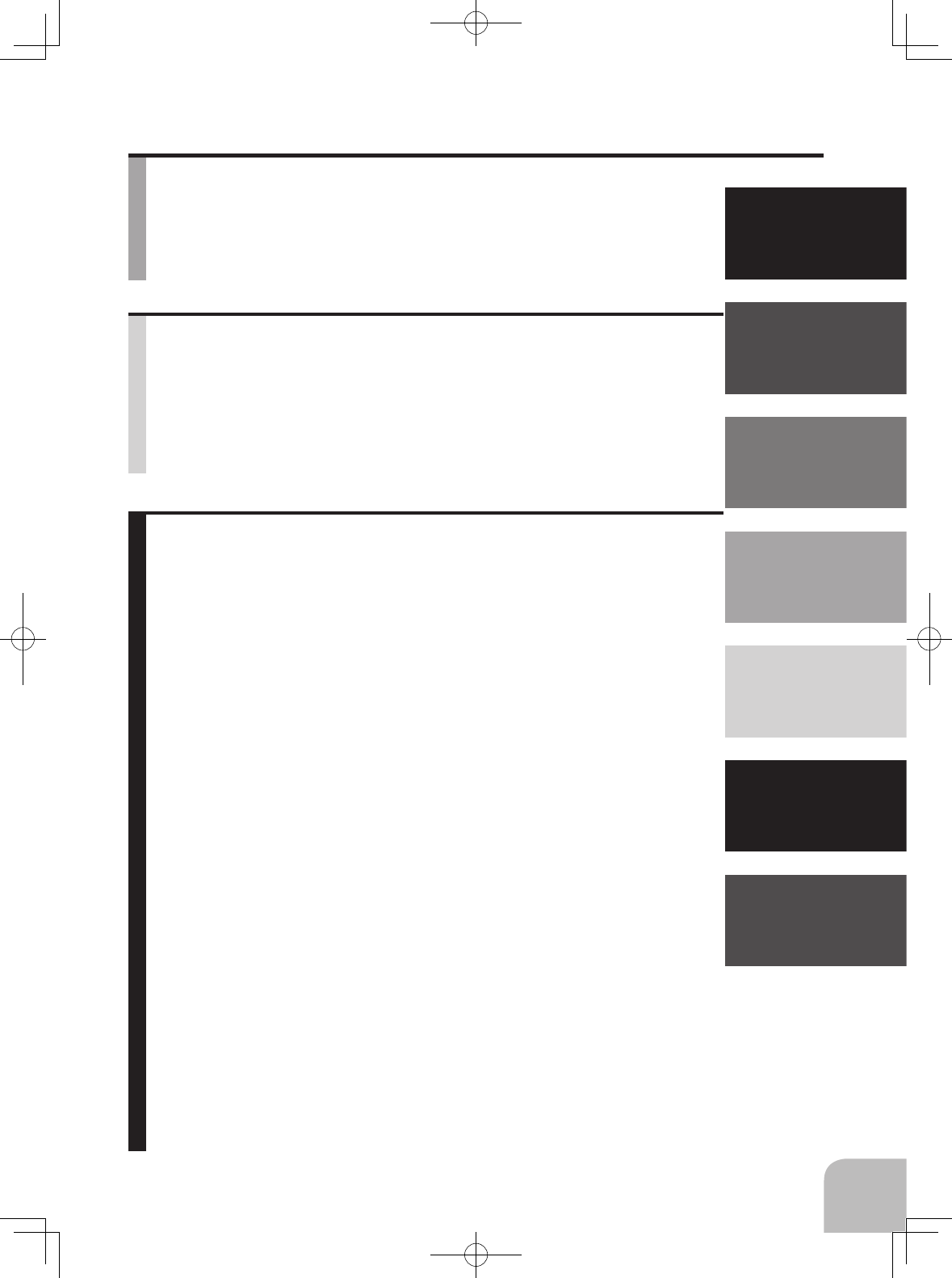
5
Before
Using
Function
Map
Functions
For Your Safety
As Well As
That Of Others
Installation
Reference
Initial
Set-Up
Function Map .....................................................................43
Operation Of Screen ...................................................................43
Selecting the Menu Screen ......................................................43
Selecting Items On The Menu Screen .....................................44
Value Of Each Function And Changing The Set Value ...........44
Basic Menu Japanese Katakana Character Display ................45
Function List ................................................................................46
Functions ...........................................................................47
Model "MODEL" .......................................................................... 47
Model Menu Display ................................................................. 47
Model Selection "SELECT" ....................................................48
Model memory select
Model Copy "COPY" ................................................................49
Model memory copy
Model Reset "RESET" ............................................................50
Model memory reset
Model Name "MDL NAME" ........................................................51
Model memory name & User name, set/modify
Servo Reverse "REVERSE" ........................................................52
Servo operation reversing
Sub trim "SUBTRIM" ..................................................................53
Servo center position fine adjustment
End Point Adjuster "END POINT" .............................................54
End point adjustment
Fail Safe Function "FAIL SAFE" ................................................. 57
Fail safe, battery fail safe function
Exponential Adjustment "EXP"..................................................59
Steering operation curve / Throttle curve adjustment
Servo Speed "SPEED" ................................................................62
Steering/ Throttle servo delay adjustment
Throttle Acceleration "TH ACCEL" ...........................................65
Function which adjusts the initial response from the throttle neutral position
A.B.S. Function "TH A.B.S" .......................................................67
Pulse brake
Initial Set-Up .......................................................................37
Preparations (Transmitter) ..........................................................37
Receiver Type Check (RX MODE) ..........................................37
Receiver Type Change & How To Link .................................38
Throttle Mode Check ................................................................41
Trims Initial Set-Up ...................................................................41

6
Channel 3/4 "CH3/CH4" ...............................................................71
Channel 3/4 Position
Steering Dual Rate/ Throttle ATL "D/R ATL" ..............................72
Steering D/R, Throttle ATL Rate
Select Switch Dial Function "SW/ DIAL" ...................................73
Selection of functions operated by dial, digital trim and switch
Brake Mixing "BRAKE MIX" .......................................................76
Front and rear independent brake control for 1/5GP car, etc.
Programmable Mixing "PROG MIX" ..........................................78
Programmable mixing between specific channels
4WS Mixing "4WS" ......................................................................80
Special mixing used with Crawler and other 4WS type vehicles
Dual ESC Mixing "DUAL ESC" ...................................................82
Special mixing used with Crawler and other 4WD type vehicles
Gyro Mixing "GYRO MIX" ............................................................84
Used to set the Futaba car rate gyro.
CPS Mixing "CPS MIX" ................................................................86
Controls the Futaba CPS-1 channel power switch.
Throttle Mode "TH MODE" .........................................................88
Throttle Servo Neutral Position "SXNT" ...................................88
Throttle servo forward and brake operation proportion setting
Idle-Up "IDLUP" ......................................................................89
Idle up at engine start
Neutral Brake "NTBRK" ............................................................90
Neutral brake function
Throttle Off (Engine Cut) "THOFF" .........................................91
Engine cut off by switch
ESC Link Function "MC LINK" ...................................................92
Special function, Futaba ESC (MC940CR, MC960CR, MC950CR, MC851C,
MC602C, MC402CR, etc.)
Data Transfer "MDL TRANS" ..................................................... 100
The T4GRS model memory data to another T4GRS
Timer Function "TIMER" ..........................................................102
Up, Fuel down, or lap timer
Lap List "LAP LIST" .................................................................108
Lap timer data check
System Functions "SYSTEM" .................................................109
Liquid crystal screen contrast adjustment
Liquid crystal screen backlighting display mode setup
Backlight display time setup
Backlight brightness setup
Battery type setting
Buzzer sound tone adjustment
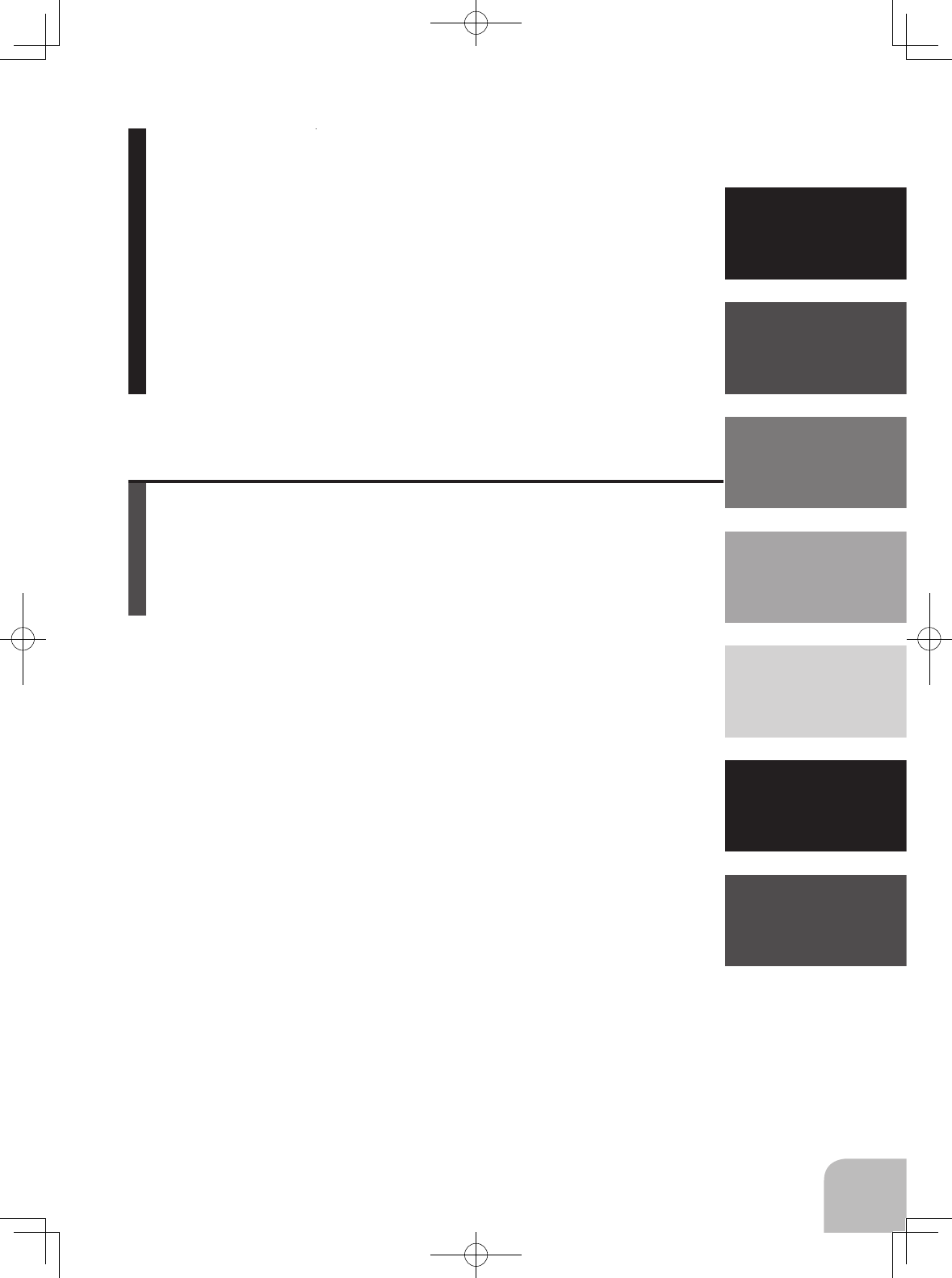
7
Before
Using
Function
Map
Functions
For Your Safety
As Well As
That Of Others
Installation
Reference
Initial
Set-Up
Reference .........................................................................123
Ratings ......................................................................................123
Warning Displays .....................................................................124
Optional Parts ...........................................................................126
When requesting repair ............................................................126
Alarm Setting if Tx is left switched ON
Item which displays the basic menu screen in katakana characters for Japanese use
Throttle stick adjustment
HOME screen display mode setting
Adjuster "ADJUSTER" ..............................................................113
Steering wheel and throttle trigger correction
Telemetry "TELEMETRY" .........................................................115
Telemetry/ Log Screen Map ...................................................116
Telemetry Function ON/OFF ..................................................117
Telemetry Sensor Setting ....................................................... 118
Log Setting, Start/ Stop .......................................................... 120
Log Data List ..........................................................................122
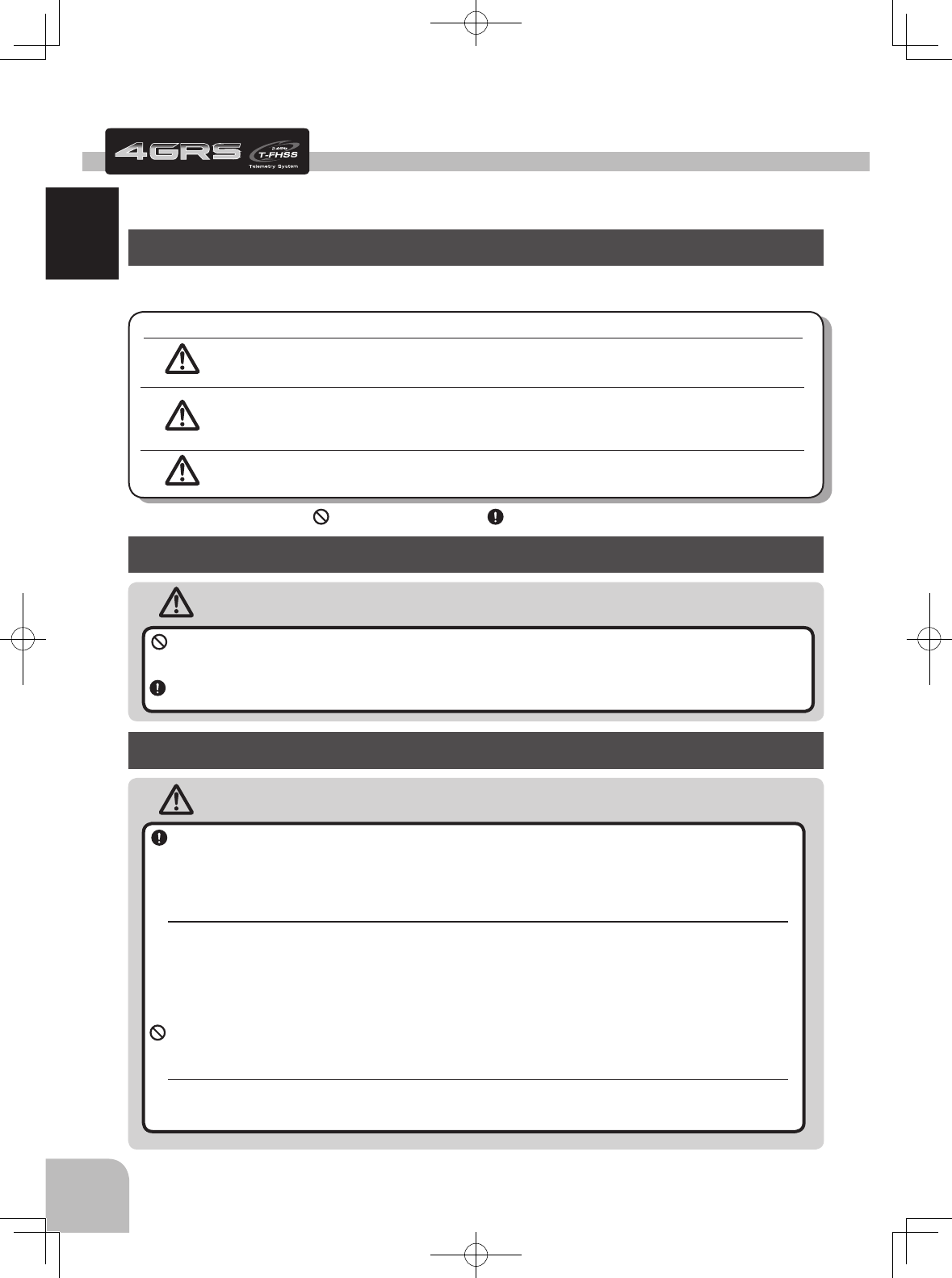
Warning
Caution
When using the T4GRS in the T-FHSS (HIGH) and S-FHSS (HIGH) mode, always use it under
the following conditions:
Servos :
Futaba digital servo (including BLS Series brushless servos)
Receiver’s battery :Matched to the ratings of the receiver and connected digital servo (dry cell battery cannot be used).
Transmitter mode :
RX MODE
Under other conditions, the set will not operate, or the specified performance will not be displayed even if it operates.
In addition, it may cause servo trouble. Futaba will not be responsible for damage, etc. caused by combination with the
products of other companies.
In addition, the FSU Fail Safe Unit cannot be used because the system is different. Use the fail safe function of the trans-
mitter.
When using analog servos, always switch the T4GRS servo response to the "NORM" mode.
Transmitter mode
:"
T-FHSS(NORM)", "T-FHSS(NORM)"and FHSS mode
Receiver’s battery :Matched to the ratings of the receiver and connected servo (dry cell battery cannot be used).
The set cannot operate in the "HIGH" mode. Operation in this mode will cause trouble with the servo and other equipment.
Digital servos (including BLS Series brushless servos) can also be used in the "NORM" mode.
8
For Your Safety As Well As That Of Others
For Your Safety As Well As That Of Others
Use this product in a safe manner. Please observe the following safety precautions at all
times.
Explanation Of Symbols
The parts of this manual indicated by the following symbols are extremely important
and must be observed.
Danger
Indicates procedures which may lead to dangerous situations and could
cause death or serious injury as well as superficial injury and physical
damage.
Indicates procedures that may not cause serious injury, but could lead to
physical damage.
Symbols: : Prohibited : Mandatory
Indicates a procedure which could lead to a dangerous situation and may
cause death or serious injury if ignored and not performed properly.
Warning
Caution
Symbols Explanation
2.4GHz System Precautions
Special attention should be paid before turning on the system while other cars are running or oth-
er airplanes are flying because the 2.4GHz RC system could potentially affect them.
Be sure to set the Fail Safe function.
Receiver Mode Precautions
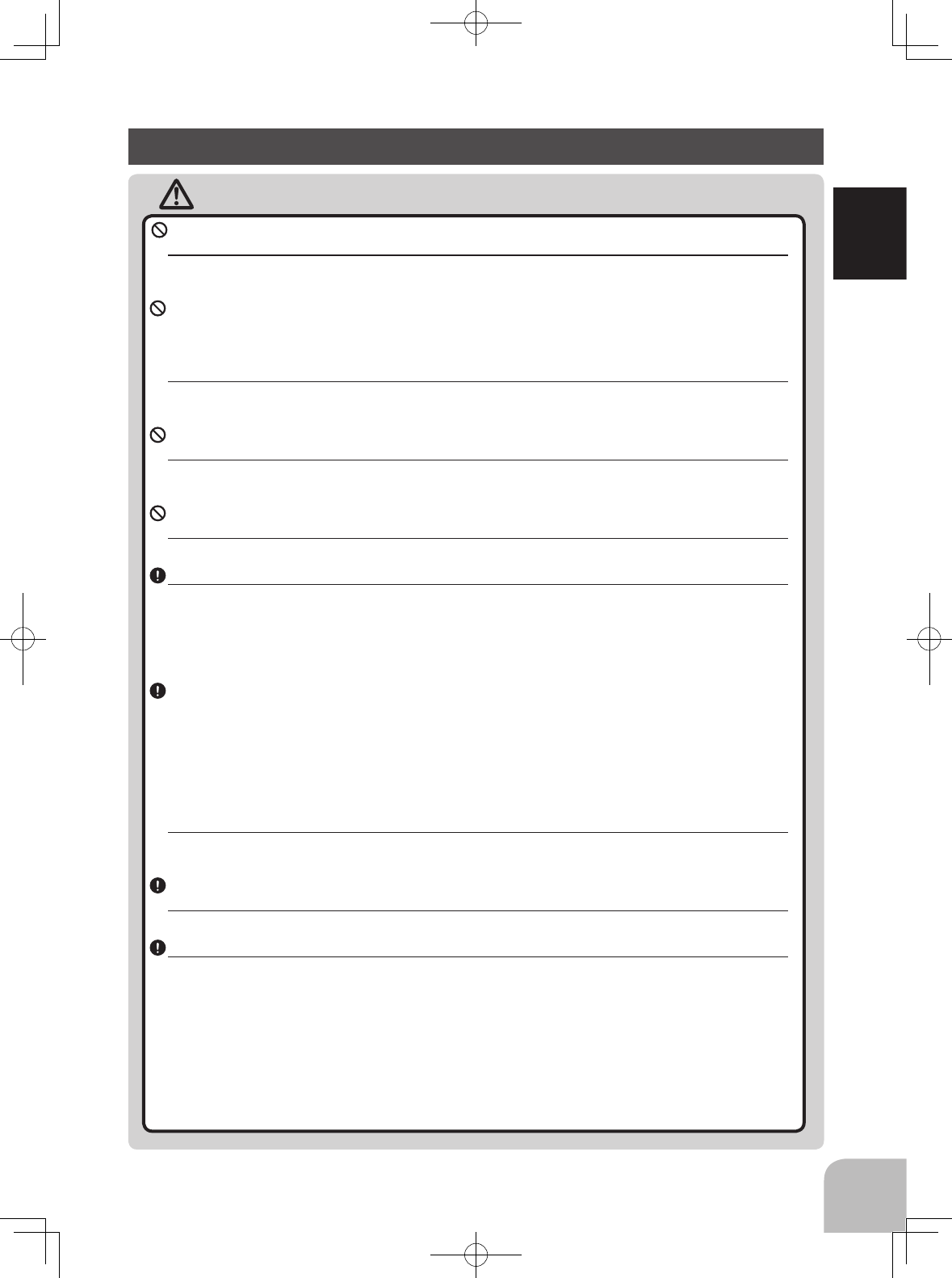
9
For Your Safety As Well As That Of Others
Warning
Do not operate outdoors on rainy days, run through puddles of water or use when visibility is lim-
ited.
Should any type of moisture (water or snow) enter any component of the system, erratic operation and loss of control
may occur.
Do not operate in the following places.
-Near other sites where other radio control activity may occur.
-Near people or roads.
-On any pond when passenger boats are present.
-Near high tension power lines or communication broadcasting antennas.
Interference could cause loss of control. Improper installation of your Radio Control System in your model could result in
serious injury.
Do not operate this R/C system when you are tired, not feeling well or under the influence of alco-
hol or drugs.
Your judgment is impaired and could result in a dangerous situation that may cause serious injury to yourself as well as
others.
Do not touch the engine, motor, speed control or any part of the model that will generate heat
while the model is operating or immediately after its use.
These parts may be very hot and can cause serious burns.
Always perform an operating range check prior to use.
Problems with the radio control system as well as improper installation in a model could cause loss of control.
(Simple range test method)
Have a friend hold the model, or clamp it down or place it where the sticks or prop cannot come in contact with any ob-
ject. Walk away and check to see if the servos follow the movement of the controls on the transmitter. Should you notice
any abnormal operation, do not operate the model. Also check to be sure the model memory matches the model in use.
Turning on the power switches.
Always check the throttle stick on the transmitter to be sure it is at the neutral position.
1. Turn on the transmitter power switch.
2. Turn on the receiver or speed control power switch.
Turning off the power switches
Always be sure the engine is not running or the motor is stopped.
1. Turn off the receiver or speed control power switch.
2. Then turn off the transmitter power switch.
If the power switches are turned off in the opposite order, the model may unexpectedly run out of control and cause a
very dangerous situation.
When making adjustments to the model, do so with the engine not running or the motor discon-
nected.
You may unexpectedly lose control and create a dangerous situation.
Before running (cruising), check the fail safe function.
Check Method; Before starting the engine, check the fail safe function as follows:
1) Turn on the transmitter and receiver power switches.
2) Wait at least one minute, then turn off the transmitter power switch. (The transmitter automatically transfers the fail
safe data to the receiver every minute.)
3) Check if the fail safe function moves the servos to the preset position when reception fails.
The fail safe function is a safety feature that minimizes set damage by moving the servos to a preset position when
reception fails. However, if set to a dangerous position, it has the opposite effect. When the reverse function was
used to change the operating direction of a servo, the fail safe function must be reset.
Setting example: Throttle idle or brake position
Operation Precautions
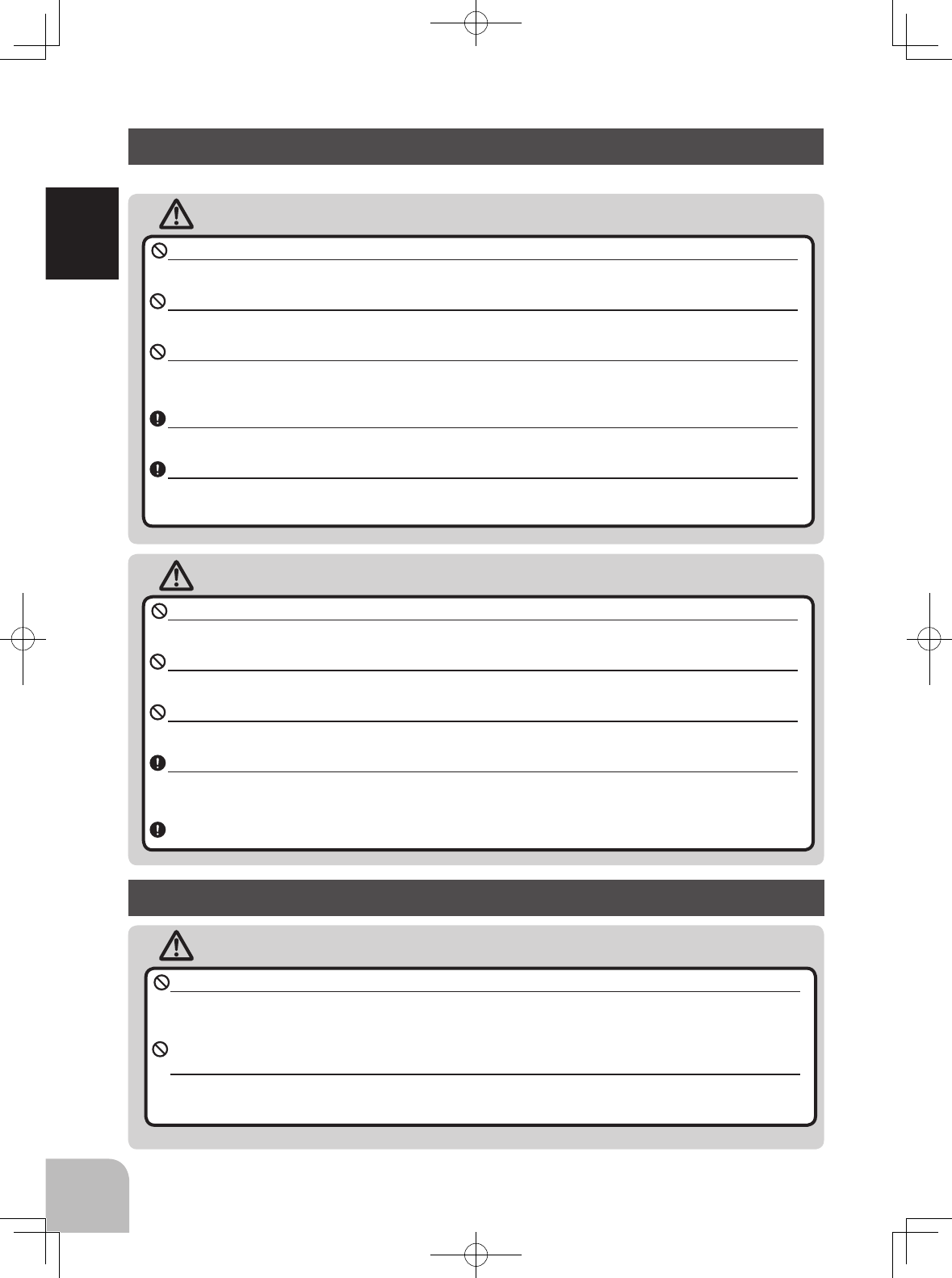
Caution
Warning
10
For Your Safety As Well As That Of Others
(Only when NiMH/NiCd /LiFe batteries are used)
NiMH / NiCd / LiFe Battery Handling Precautions
Never plug the charger into an outlet of other than the indicated voltage.
Plugging the charger into the wrong outlet could result in an explosion or fire.
Never insert or remove the charger while your hands are wet.
You may get an electric shock.
Do not use the T4GRS transmitter's battery, as the receiver's battery.
Since the transmitter's battery has an overload protection circuit, the output power will be shut down when the high current
load is applied. This may result in runaway or fatal crash.
Always check to be sure your batteries have been charged prior to operating the model.
Should the battery go dead while the model is operating, loss of control will occur and create a very dangerous situation.
To recharge the transmitter battery, use the special charger made for this purpose.
Overcharging could cause the battery to overheat, leak or explode. This may lead to fire, burns, loss of sight and many
other types of injuries.
Do not use commercial AA size NiCd and NiMH batteries.
Quick charging may cause the battery contacts to overheat and damage the battery holder.
Do not short circuit the battery terminals.
A short circuit across the battery terminals may cause abnormal heating, fire and burns.
Do not drop the battery or expose it to strong shocks or vibrations.
The battery may short circuit and overheat; electrolyte may leak out and cause burns or chemical damage.
When the model is not being used, always remove or disconnect the battery.
Leaving the battery connected could create a dangerous situation if someone accidentally turns on the receiver power
switch. Loss of control could occur.
Always keep the charger disconnected from the outlet while it is not in use.
Storage And Disposal Precautions
Warning
Do not leave the radio system or models within the reach of small children.
A small child may accidentally operate the system. This could cause a dangerous situation and injuries. NiCd batteries can
be very dangerous when mishandled and cause chemical damage.
Do not throw NiMH/NiCd/LiFe batteries into a fire. Do not expose batteries to extreme heat. Also do
not disassemble or modify a battery pack.
Overheating and breakage will cause the electrolyte to leak from the cells and cause skin burns, loss of sight, and other in-
juries.
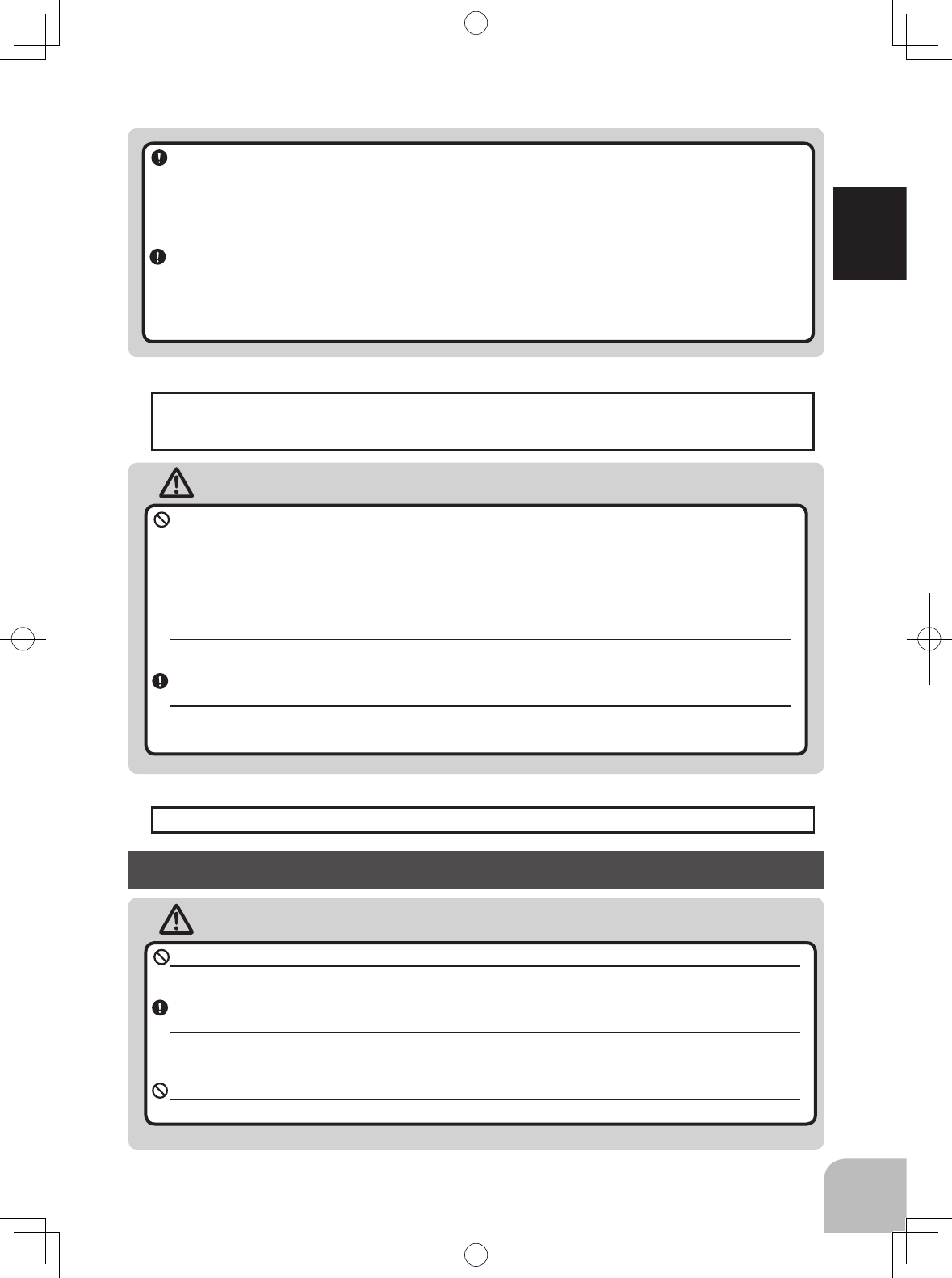
Warning
11
For Your Safety As Well As That Of Others
When the system will not be used for any length of time, store the system with NiMH/NiCd batteries
in a discharged state. Be sure to recharge the batteries prior to the next time the system is used.
If the batteries are repeatedly recharged in a slightly discharged state, the memory effect of the NiMH/NiCd battery may
considerably reduce the capacity. A reduction in operating time will occur even when the batteries are charged for the rec-
ommended time. (After discharge to 1cell E.V.=1V)
When the LiFe batteri
es
will not be used for a long time, to prevent it from deteriorating we recom-
mend that it be kept in about the half capacity state instead of fully charged. Also be careful that
the battery does not enter the over-discharged state due to self-discharge.
Periodically (about every 3 months) charge the battery.
<NiMH/NiCd Battery Electrolyte>
The electrolyte in NiCd/NiMH batteries is a strong alkali. Should you get even the smallest amount of the electrolyte in
your eyes, DO NOT RUB. Wash immediately with water, and seek medical attention at once. The electrolyte can cause
blindness. If electrolyte comes in contact with your skin or clothes, wash with water immediately.
Do not store your R/C system in the following places.
- Where it is extremely hot or cold.
- Where the system will be exposed to direct sunlight.
- Where the humidity is high.
- Where vibration is prevalent.
- Where dust is prevalent.
- Where the system would be exposed to steam and condensation.
Storing your R/C system under adverse conditions could cause deformation and numerous problems with operation.
If the system will not be used for a long period of time, remove the batteries from the transmitter
and model and store in a cool, dry place.
If the batteries are left in the transmitter, electrolyte may leak and damage the transmitter. This applies to the model also.
Remove the batteries from it also to prevent damage.
Caution
Do not expose plastic parts to fuel, motor spray, waste oil or exhaust.
The fuel, motor spray, waste oil and exhaust will penetrate and damage the plastic.
Always use only genuine Futaba transmitters, receivers, servos, ESCs (electronic speed controls),
NiMH/NiCd batteries and other optional accessories.
Futaba will not be responsible for problems caused by the use of other than genuine Futaba parts. Use the parts specified
in the instruction manual and catalog.
Never use the R304SB-E in GP (Engine) models.
Receiver R304SB-E can be used only with EP car.
Other Precautions
<NiMH/NiCd/Li-ion Battery Recycling>
A used battery is a valuable resource. Insulate the battery terminals and dispose of the battery by taking it to a battery recycling center.

12
Before Using
-Telemetry system
The T4GRS transmitter has adopted the newly developed bidirectional communication sys-
tem "T-FHSS"
-2.4GHzSS (Spread Spectrum) radio communication system
Frequency channel setting is unnecessary: Channel shifting takes place within the 2.4GHz
band automatically. This system minimizes the interference from other 2.4GHz systems.
-Model memory for 40 models
Model names can use up to 10 letters, numbers, and symbols, so that logical names may be
used. A model memory with different setups can be created by using the model copy func-
tion.
- Menu Selection
The setup screens are called from menu screens. The menu screen can be selected from
among 2 levels (LEVEL1/LEVEL2).
-Brake mixing for large cars (BRAKE)
Brake mixing of the front and rear sticks of 1/5GP and other large cars can be adjusted inde-
pendently.
-4WS mixing for crawlers and other 4WS type (4WS)
This function can be used with crawlers and other 4WS type vehicles.
-Dual ESCs mixing for crawlers cars (DUAL ESC)
ESC at the front and rear are controlled independently.
-Gyro mixing (GYRO MIX)
The sensitivity of Futaba car rate gyros can be adjusted from the T4GRS.
-CPS-1 mixing (CPS MIX)
LED lighting and ashing control using our CPS-1 channel power switch can be matched to
steering and throttle operation by switch only.
-Anti-skid braking system (TH A.B.S)
This function applies the brakes so that the tires of gasoline engine cars, etc. do not lose
their grip on the road even when braking at corners.
-Throttle acceleration (ACCEL)
Gasoline engine cars have a time lag before the clutch and brakes become effective.
The throttle acceleration function reduces this time lag.
Before Using
Features

13
Before Using
-Throttle speed (SPEED)
Sudden stick operation on a slippery road surface will only cause the tires to spin and the
model to not accelerate smoothly. By setting the throttle speed function, operation can be
performed smoothly and easily. It also suppresses battery consumption.
-Steering speed (SPEED)
When you sense that the steering servo is too fast, etc., the servo operating speed (direction
that suppresses the maximum speed) can be adjusted.
-Racing timer (TIMER)
The lap timer can record 100 lap times and total time. The timer can also be started auto-
matically by stick operation. The race time and audible alarm can be set.
Re-/fueling time are indicated by an audible alarm. An up timer is also provided.
-Digital trim
The current trim position is displayed on the LCD screen. The operating amount of 1 step
can also be adjusted.
Trim operation has no effect on the maximum travel of the steering and throttle servos.
-Function select switch / dial function (TRIM DIAL)
This function assigns functions to 2 switches and dials (digital trim, digital dial). The step
amount and operating direction can also be adjusted. Trim positioning at each model call is
unnecessary because all the dials are digital.
-ESC-Link function (MC-LINK)
This is a dedicated function which allows setting of the contents of the Link software which
makes possible Futaba speed controller (ESC), MC950CR, MC850C, MC851C, MC602C,
MC402CR, etc. variable frequency and other data changes by T4GRS.
-Tension adjustment function
The tension of the steering stick & throttle stick springs can be adjusted from the inside.
-Adjustable Throttle Stick Travel (Mechanical ATL Adjustment)
Make this adjustment when you want to decrease the total travel of the forward (up) side or
brake (down) side of the throttle stick.
-Display switch
Display switch allows function setup without transmitting.
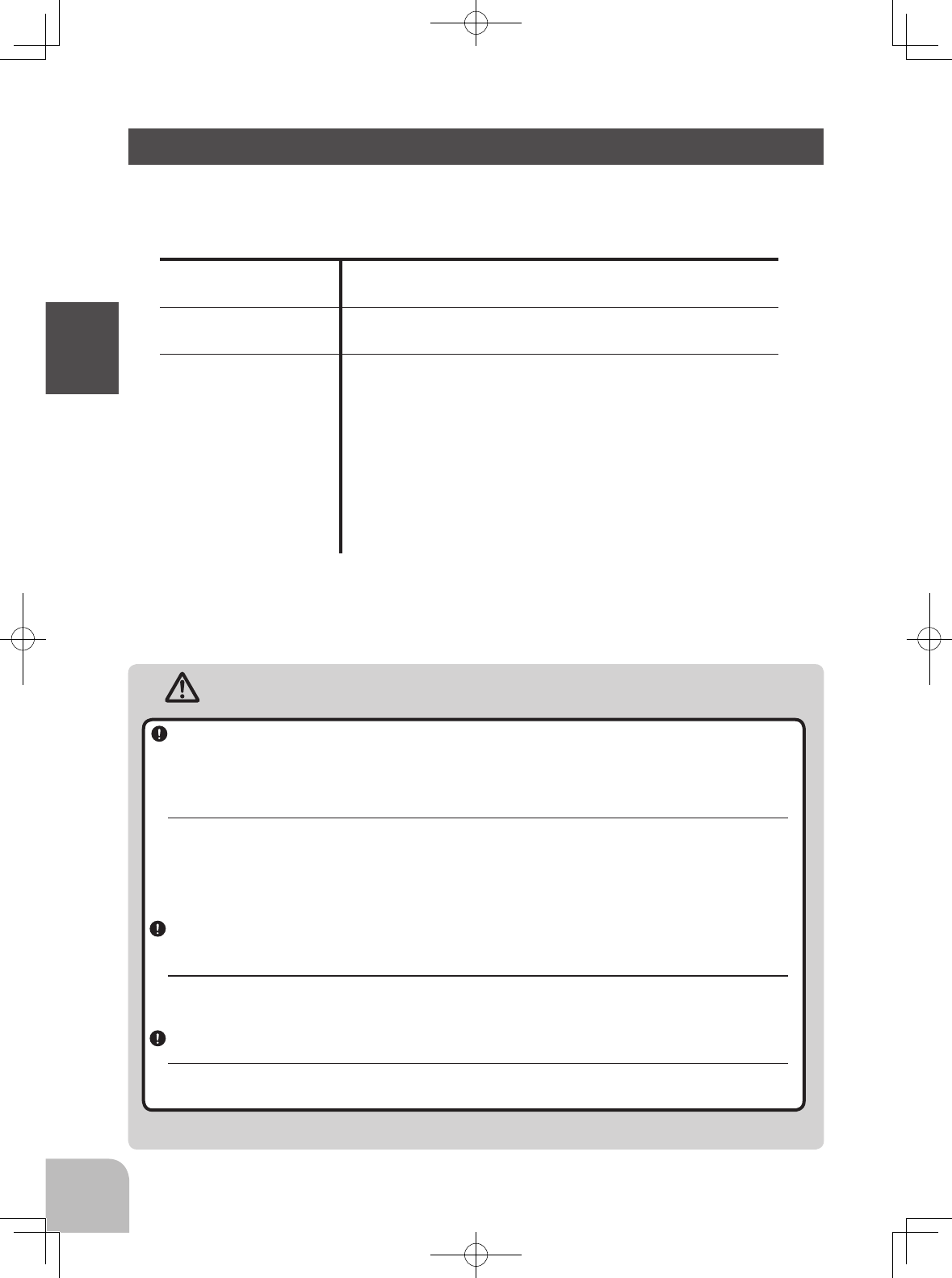
14
Before Using
After opening the box, rst check if the contents conform to the following. The contents
depend on the set as shown below.
Set Contents
Transmitter T4GRS
Receiver R304SB or R304SB-E(Built-in Antenna for EP car models)
Miscellaneous
Receiver switch
* It is not attached to R304 SB-E set.
Mini screwdriver
* It is used for receiver.
Instruction manual
- If any of the set contents are missing, or you have any questions, please contact
your dealer.
Caution
When using the T4GRS in the T-FHSS (HIGH) and S-FHSS (HIGH) mode, always use it under
the following conditions:
Servos :
Futaba digital servo (including BLS Series brushless servos)
Receiver’s battery :Matched to the ratings of the receiver and connected digital servo (dry cell battery cannot be used).
Transmitter mode :
RX MODE
Under other conditions, the set will not operate, or the specified performance will not be displayed even if it operates.
In addition, it may cause servo trouble. Futaba will not be responsible for damage, etc. caused by combination with the
products of other companies.
In addition, the FSU Fail Safe Unit cannot be used because the system is different. Use the fail safe function of the trans-
mitter.
When using analog servos, always switch the T4GRS servo response to the "NORM" mode.
Transmitter mode
:"
T-FHSS(NORM)", "T-FHSS(NORM)"and FHSS mode
Receiver’s battery :Matched to the ratings of the receiver and connected servo (dry cell battery cannot be used).
The set cannot operate in the "HIGH" mode. Operation in this mode will cause trouble with the servo and other equipment.
Digital servos (including BLS Series brushless servos) can also be used in the "NORM" mode.
Always use only genuine Futaba transmitters, receivers, servos, ESCs (electronic speed con-
trols), NiMH, NiCd, Li-ion batteries and other optional accessories.
Futaba will not be responsible for problems caused by the use of other than Futaba genuine parts. Use the parts speci-
fied in the instruction manual and catalog.
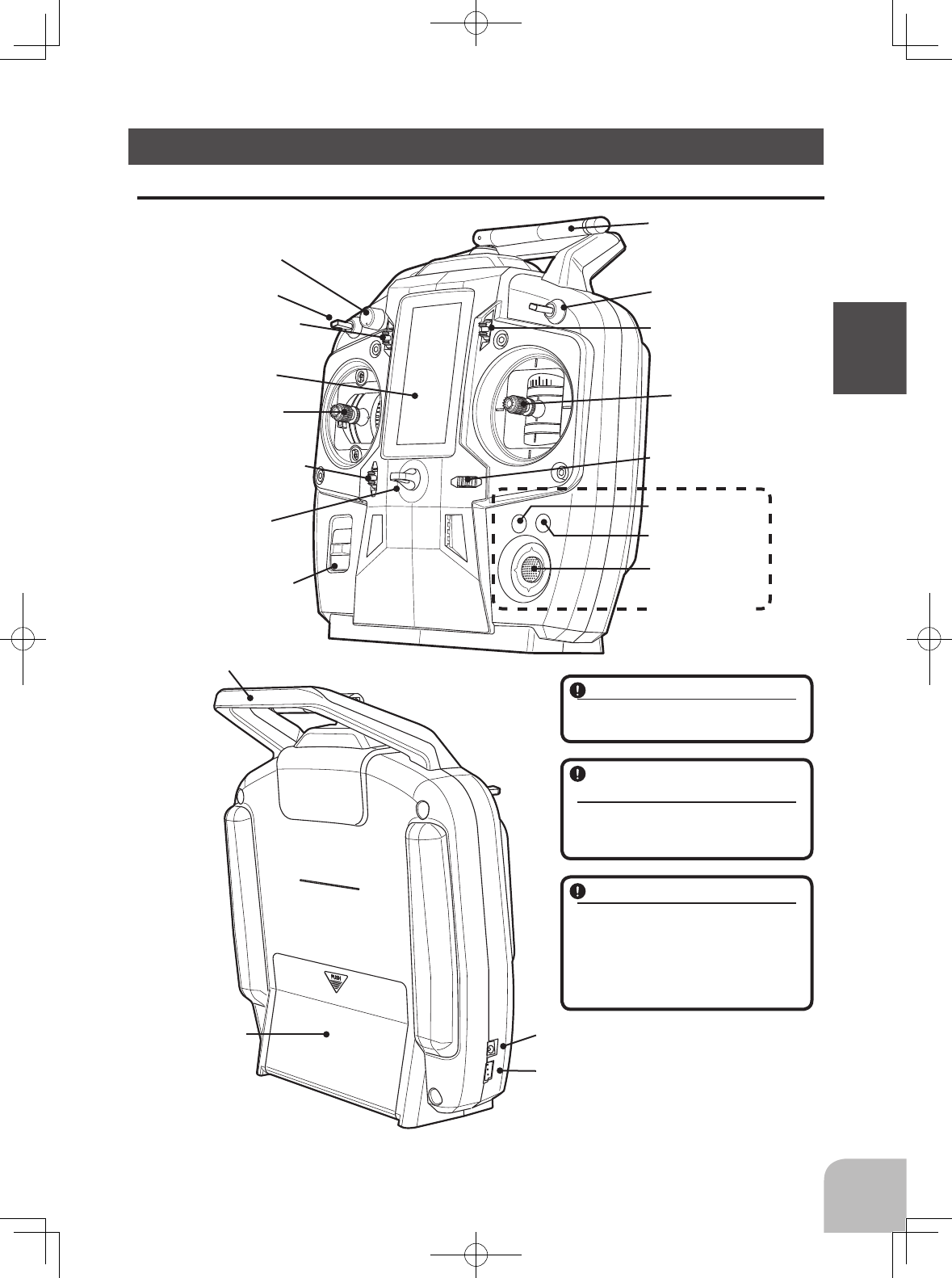
15
Before Using
*The switches, dial, and trimmers in the gure are shown in the initial setting position.
Antenna
Digital Dial 1 (DL1)
(default CH4)
Throttle stick
Power&Display
switch
Digital Trim 2 (DT2)
(default throttle trim)
Digital Trim 4 (DT4)
(default ATL) Digital Trim 3 (DT3)
(default dual rate)
Grip Handle
Digital Trim1 (DT1)
(default steering trim)
Steering stick
Switch 1 (SW1)
Switch 2 (SW2)
(default CH3)
LCD screen
Nomenclature
Transmitter T4GRS
Battery cover
+Button
-Button
Jog Button
Charge jack (Only for NiMH)
Communication port
Hook
Do not carry the transmitter by
the antenna.
There is the danger that the antenna
wire will break and operation will
become impossible.
Stick lever head the precautions.
There is a small projection at the tip
of the lever heads to prevent slipping.
When carrying the transmitter, be
careful these projections do not
damage your skin, clothes, or other
objects.
Antenna cannot be removed.
Damage will occur if the antenna is
forcibly removed.
Edit Button
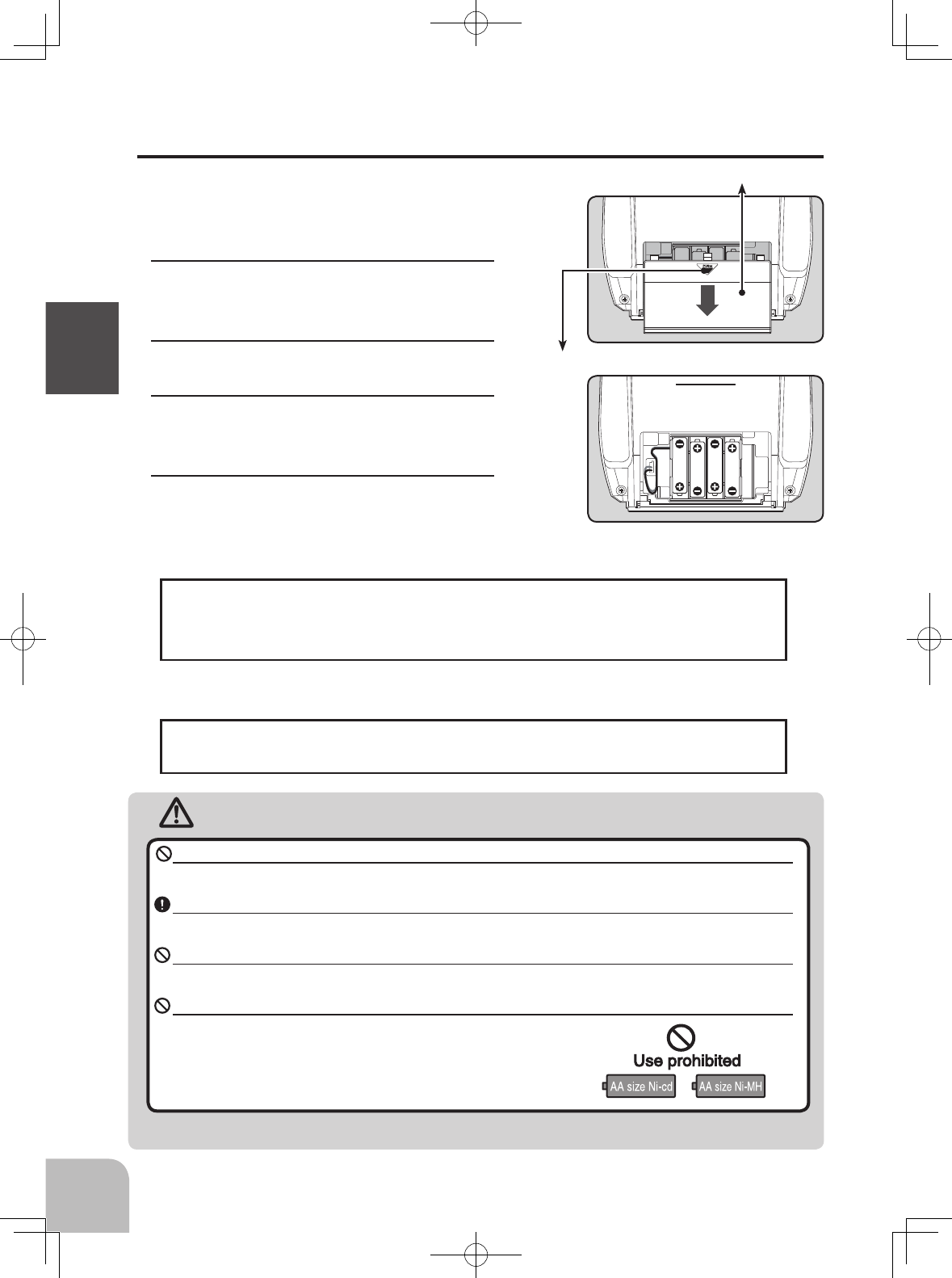
Battery cover
Slide battery cover while pressing here.
16
Before Using
Battery Replacement Method
1Remove the battery cover from the transmitter
by sliding it in the direction of the arrow in the
figure.
2Remove the used batteries.
3Load the new AA size batteries. Pay very close
attention to the polarity markings and reinsert
accordingly.
4Slide the battery cover back onto the case.
Battery Replacement Method (4 AA Size Batteries)
Load the four batteries in accordance with the po-
larity markings on the battery holder.
Check:
Turn the power switch on the transmitter to the ON position. Check the battery
voltage display on the LCD screen. If the voltage is low, check the batteries for in-
sufcient contact in the case or incorrect battery polarity.
Disposal of the Dry Cell Batteries:
The method to dispose of used dry cell batteries depends on the area in which you
reside. Dispose of the batteries in accordance with the regulations for your area.
Caution
Never try to recharge a dry cell battery.
The transmitter may be damaged or the battery electrolyte may leak or the battery may break.
Insert the batteries in the correct polarity.
If the polarity is incorrect, the transmitter may be damaged.
When the transmitter is not in use, remove the batteries.
If the battery electrolyte leaks, wipe off the case and contacts.
Do not use commercial AA size NiCd and NiMH batteries.
Quick charging may cause the battery contacts to overheat and damage the
battery holder.
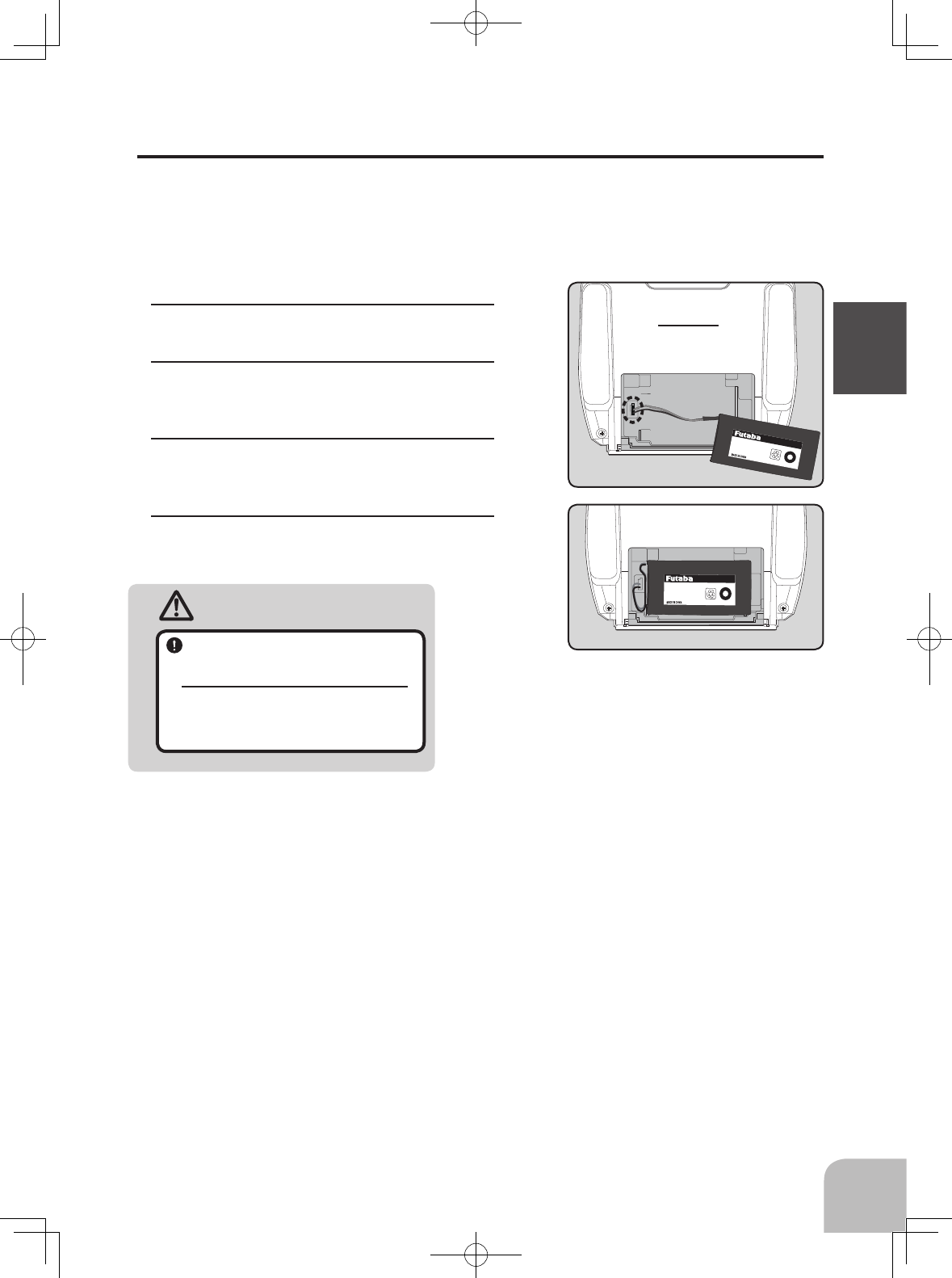
Caution
When closing the battery cover, be
careful that the battery cover does
not pinch the battery lead wires.
Shorting of the battery lead wires may lead
to fire and abnormal heating and cause
burns or fire disaster.
HT5F1700B
CAPACITY: 6.0VDC-1700mAh
CHARGING: 170mA-12hours
HT5F1700B
CAPACITY: 6.0VDC-1700mAh
CHARGING: 170mA-12hours
17
Before Using
Battery Replacement Method
1Refer to the previous description and remove the
transmitter battery cover.
2After removing the dry cell battery box from the
transmitter, disconnect the connector.
3Insert the connector of the new battery and load
the new battery into the transmitter.
4Finish by installing the battery cover.
When Using The Optional Battery
When using an optional rechargeable battery, replace the battery as described below.
-Always use the optional HT5F1800B or FT2F1700BV2/2100BV2 rechargeable battery.
-The type of power source used must be set by system setting.
-When the transmitter will not be used for a long time, remove the battery.
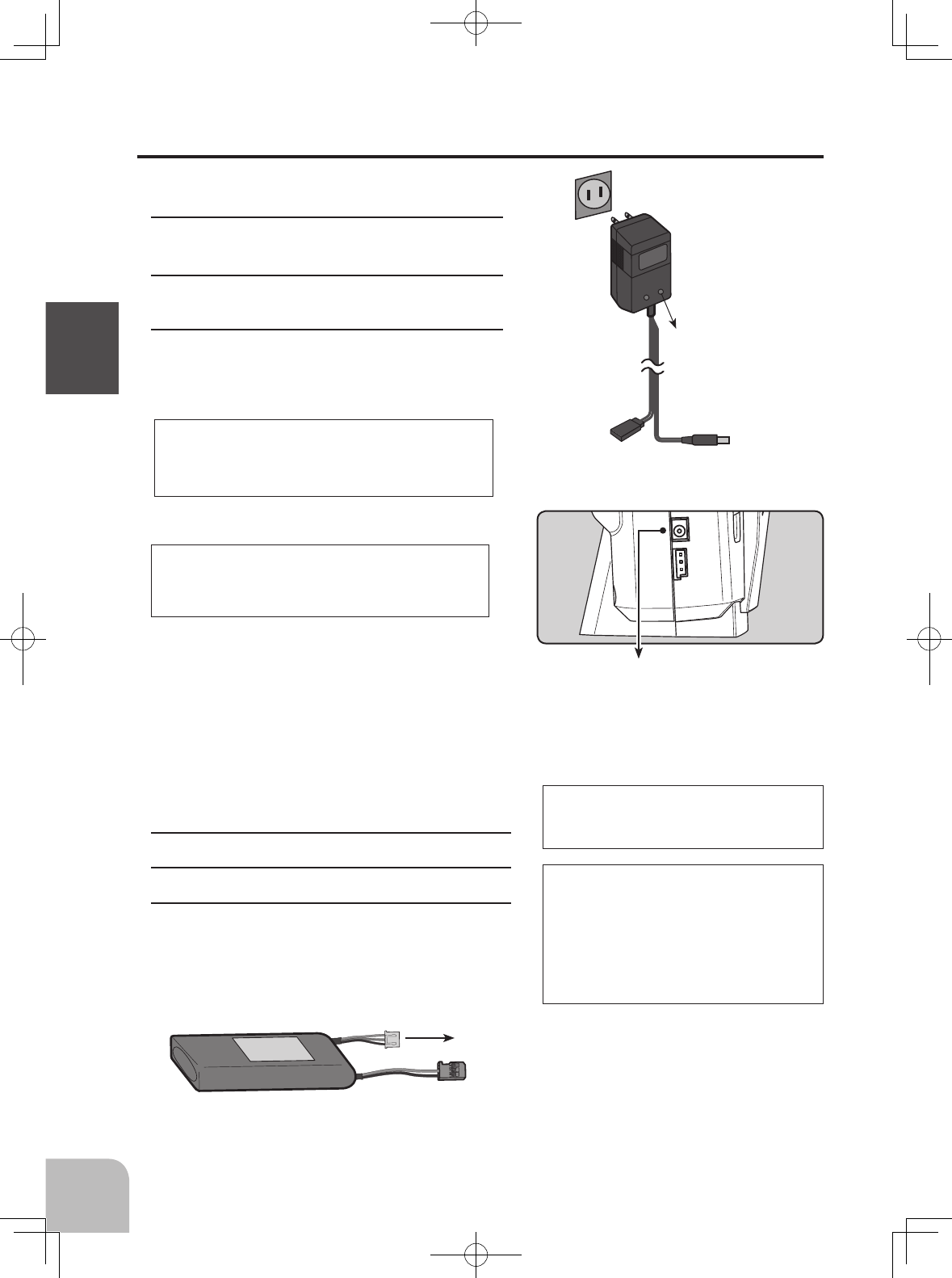
AC outlet
Charger
Transmitter
charging LED
To transmitter
charging jack
To receiver
Ni-Cd battery
Balance charging connector for
LiFe battery charger.
18
Before Using
Charging A LiFe Battery
(Example: When using the FT2F1700BV2/2100BV2 with the special
charger)
1Remove the battery cover.
2Disconnect the battery from the 4GRS
3Balance charging cannot be done through the
transmitter, you must remove the LiFe battery to do
this charge.
Charge the optional FT2F1700BV2/2100BV2
(LiFe) battery with the special charger in accor-
dance with the instruction manual supplied.
When the battery will not be used for a long time,
to prevent it from deteriorating we recommend
that it be kept in about the half capacity state in-
stead of fully charged. Also be careful that the bat-
tery does not enter the over-discharged state due
to self-discharge.
Periodically (about every 3 months) charge the
battery.
Over current protection
Charging jack
Cannot be used for
charge of LiFe.
LiFe battery is removed
from transmitter.
The transmitter charging circuit is equipped with an over cur-
rent protection circuit (1.0A). If the battery is charged with a
quick charger for other than digital proportional R/C sets, it
may not be fully charged.
The charging time when charging the HT5F1800B battery
with the optional special charger is approximately 15 hours.
However, when the battery has not been used for some time,
repeat charging 2 or 3 times to activate the battery.
Charging a NiMH Battery
(Example: When using the HT5F1800B with the special charger)
1Plug the transmitter cord of the special charger in-
to the charging jack on the rear of the transmitter.
2Plug the charger into an AC outlet.
3Check that the charging LED lights.
When Charging the Optional Battery
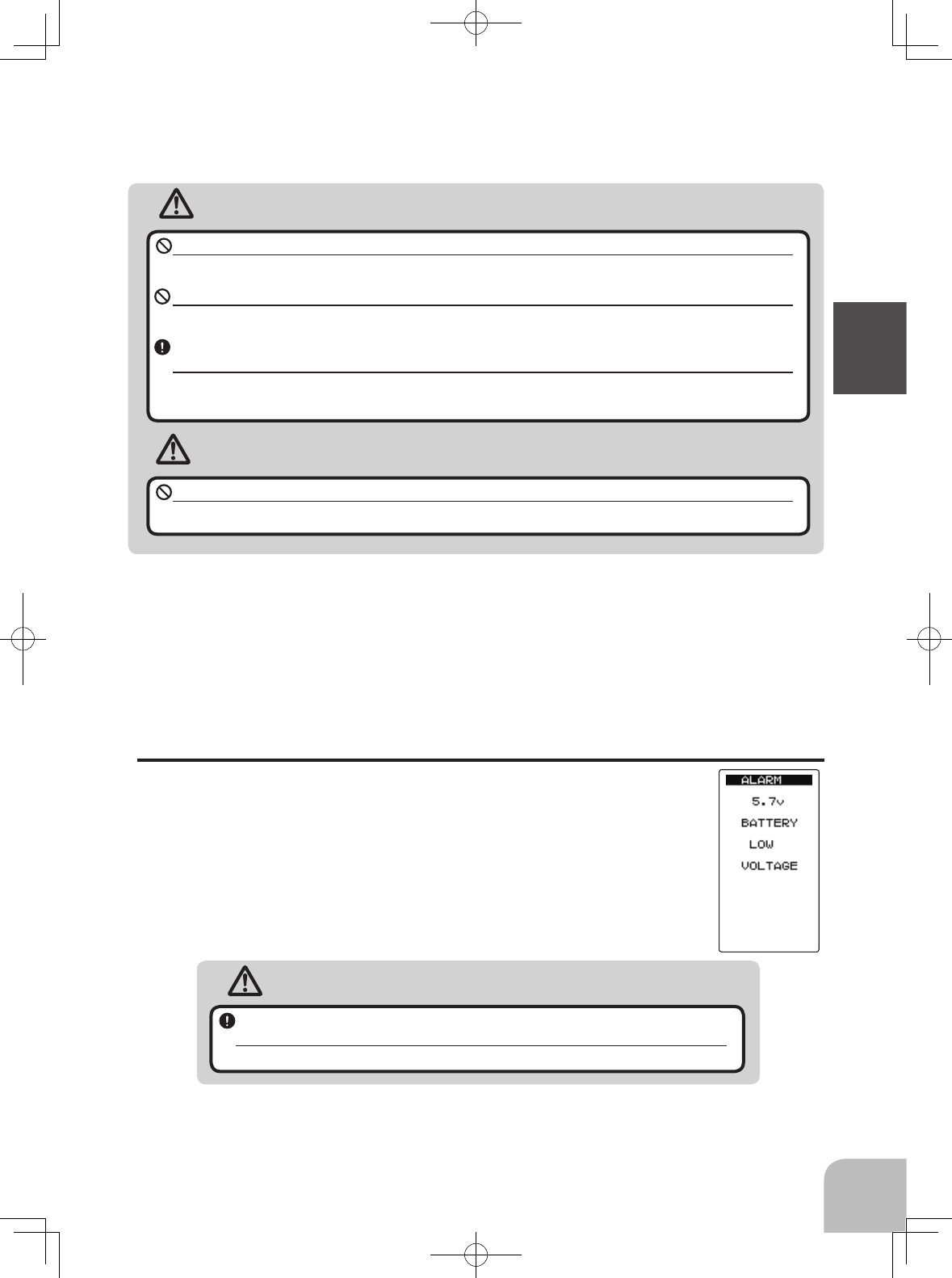
Warning
Caution
19
Before Using
Never plug it into an outlet other than the indicated voltage.
Plugging the charger into the wrong outlet could result in an explosion or fire.
Do not insert and remove the charger when your hands are wet.
It may cause an electric shock.
Always use the special charger or a quick charger for digital proportional R/C sets to charge a
digital proportional R/C set NiMH battery.
Overcharging a Ni-MH battery can result in burns, fire, injuries, or loss of sight due to overheating, breakage, or electro-
lyte leakage.
When the charger is not in use, disconnect it from the AC outlet.
Do this to prevent accidents and to avoid overheating.
Low Battery Alarm
If the transmitter battery voltage drops below the usable range, an audible
alarm will sound and "BATTERY LOW VOLTAGE" will be displayed on
the LCD screen. If the battery goes dead while running (cruising), you will
lose control of the vehicle (boat). Therefore, retrieve the vehicle (boat) im-
mediately and cease operation.
Because the low battery alarm voltage of a dry cell battery is different from
that of a rechargeable battery pack (genuine Futaba option), the type of
power source used must be set by system setting.
Warning
When a low battery alarm is generated, cease operation immediately and
retrieve the model.
If the battery goes dead while in operation, you will lose control of the model.
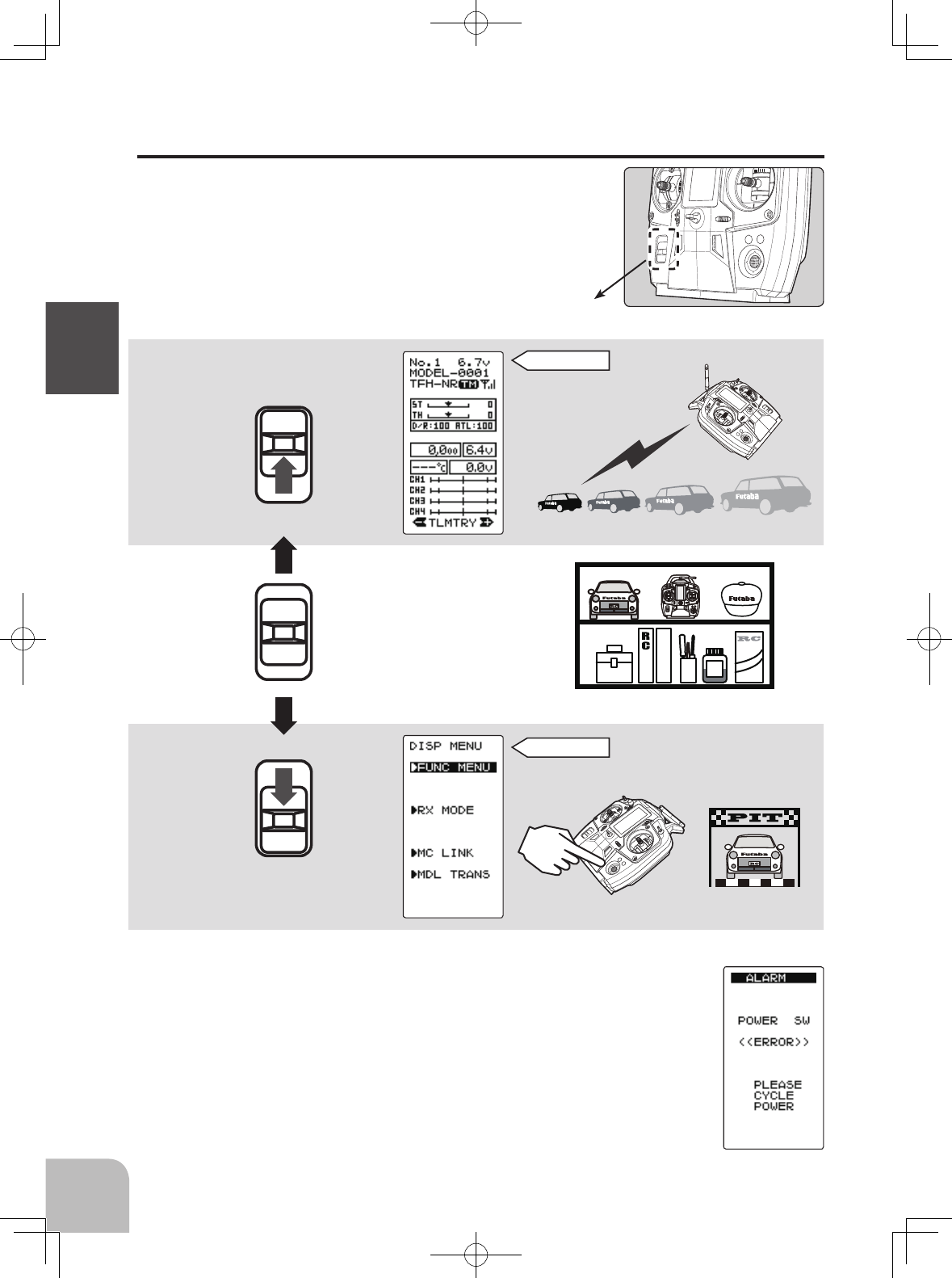
OFF
DISP
Radio waves are not being
transmitted
MIDDLE
When you do not run, turn OFF.
It cannot operate.
PWR ON
Radio waves are being transmitted
DOWN
UP
LCD screen
LCD screen
20
Before Using
Power & Display Switch
The power switch and display switch of the T4GRS are inte-
grated. In the PWR ON mode, radio waves are transmitted
and in the DISP mode, model data, settings can be checked
without transmitting radio waves.
In addition, some setting menus may only be displayed in
the DISP mode.
Precautions when turning the power switch on and off.
- When the data is changed using the edit buttons or trim levers, wait at
least two seconds before turning off the power. If the power is turned off
within two seconds after the data is changed, the new data will not be writ-
ten to memory.
- If the power switch is quickly switched from the DISP mode to the PW
ON mode or vice versa, the switch error shown at the right may be gener-
ated. If this occurs, cycle the power.
Power /DISP
Switch
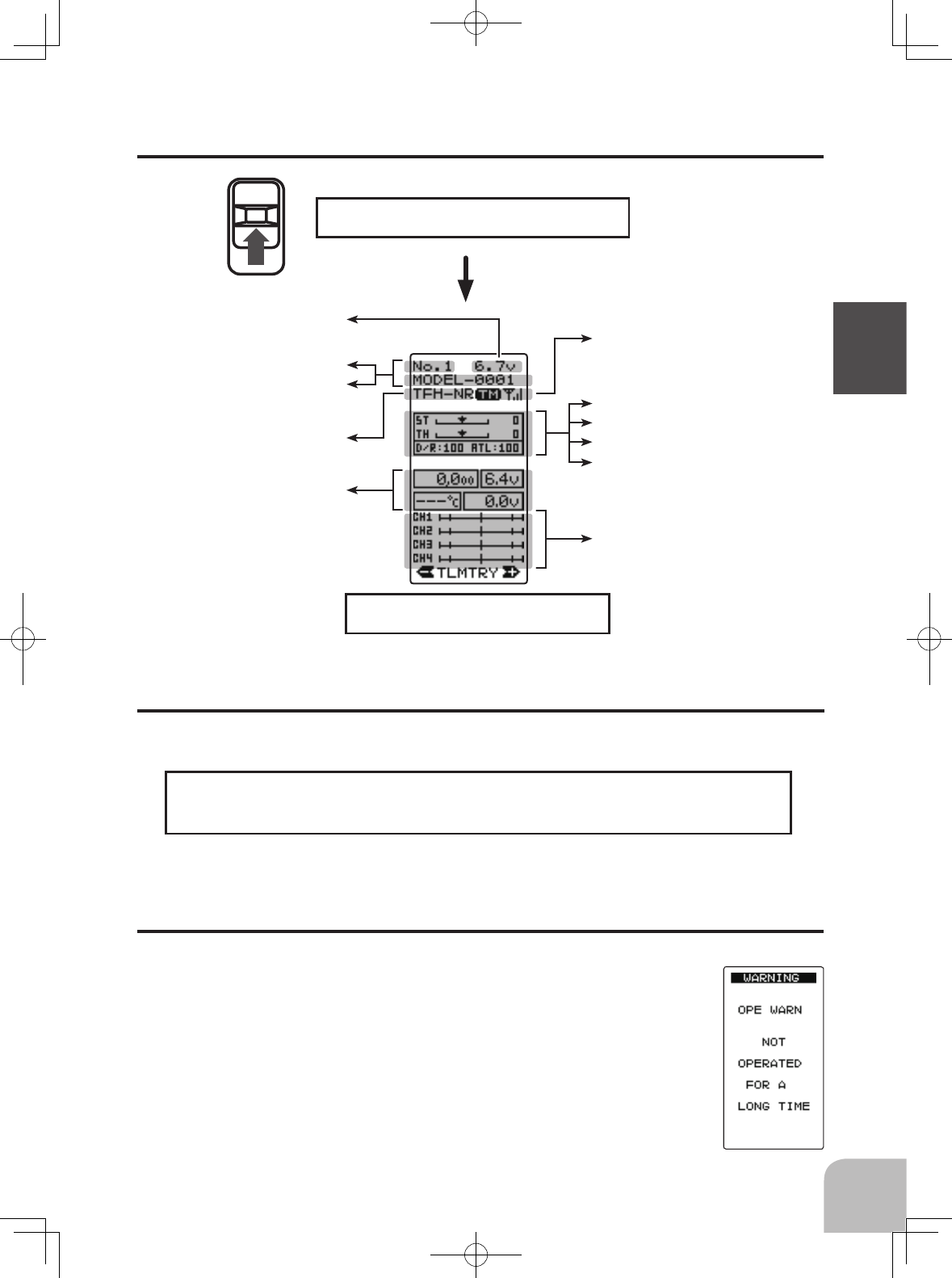
Battery voltage display
ST :Steering trim display
TH :Throttle trim display
D/R :Steering D/R display
ATL :Throttle ATL display
Power switch turned on
Beep conrmation sound is generated and the
HOME screen shown below appears.
Display When Power Switch Is Turned On
Model name (10 characters)
The current receiver mode is
displayed.
Telemetry function :ON/OFF
Receiver -> Transmitter:
The reception strength is shown.
Servo operation of each
channel can be checked.
Model number
Telemetry data
21
Before Using
LCD Screen Contrast
The LCD screen contrast can be adjusted.
Caution
Do not adjust the contrast so that the LCD is too bright or too dark.
When the display cannot be read due to a temperature change, data cannot be set.
Alarm Setting if Tx is left switched ON
When the steering stick, throttle stick, push switch, or edit button are not operated for 10
minutes (default), an alarm sounds and "NOT OPERATED FOR A LONG
TIME" is displayed on the LCD screen.
When the steering stick, throttle stick, push switch, or edit button are
operated, the alarm is reset. If the system is not to be used, turn off the
power.
The function can be deactivated in the system menu.
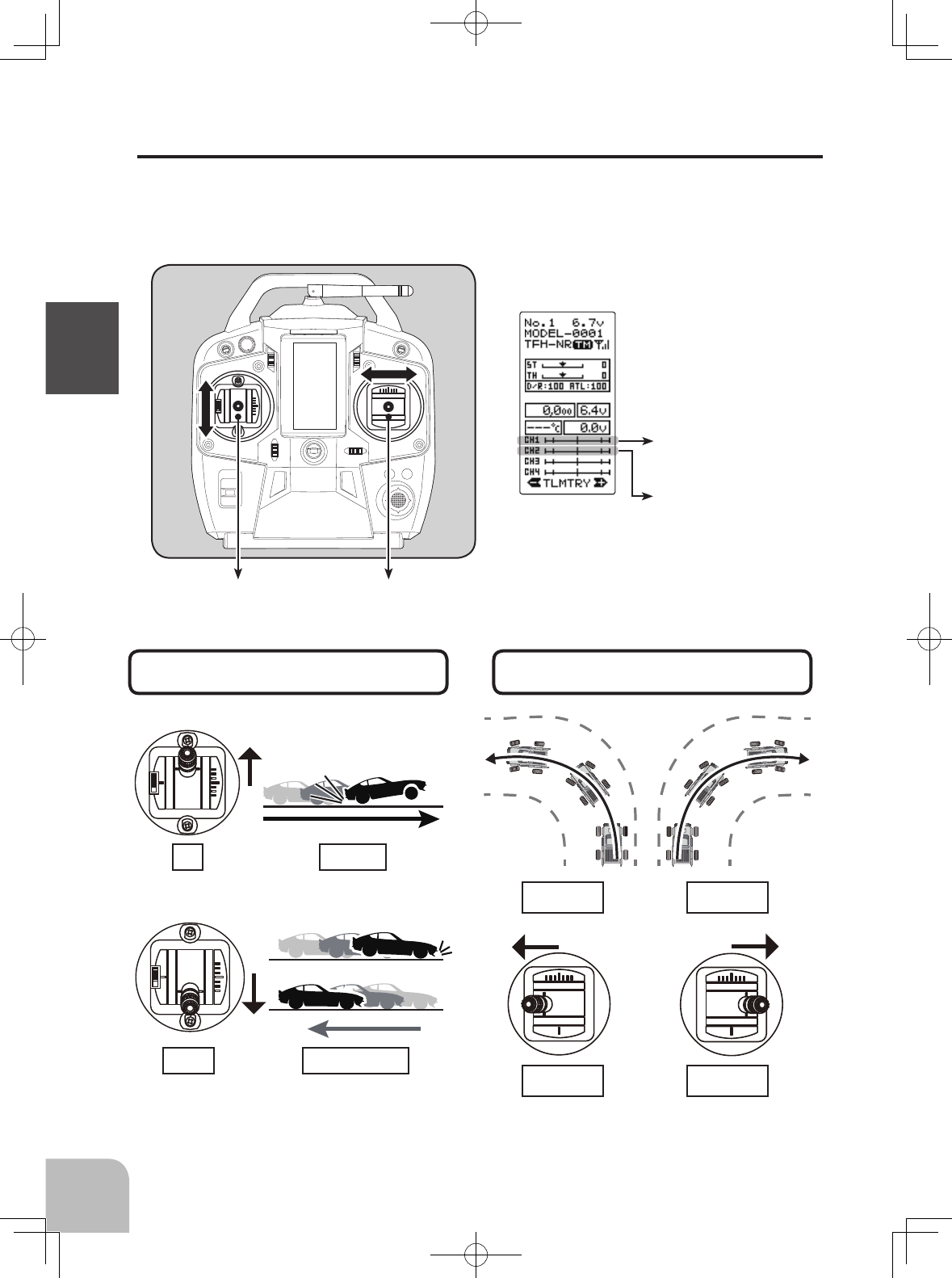
22
Before Using
Throttle stick function Steering stick function
Left turn
Left
Right turn
Right
ForwardUP
Down brake or back
( RC Car example shown )
Servo operation of steer-
ing channel (CH1)can be
checked.
Servo operation of throt-
tle channel (CH2) can be
checked.
Throttle stick
CH2
Steering stick
CH1
Stick Operation CH1 CH2
(CH1: Steering stick, CH2: Throttle stick,)
Throttle Stick Function: Controls the speed of the model as well as the direction of travel
- forward or reverse.
Steering Stick Function: Turns the model right or left.
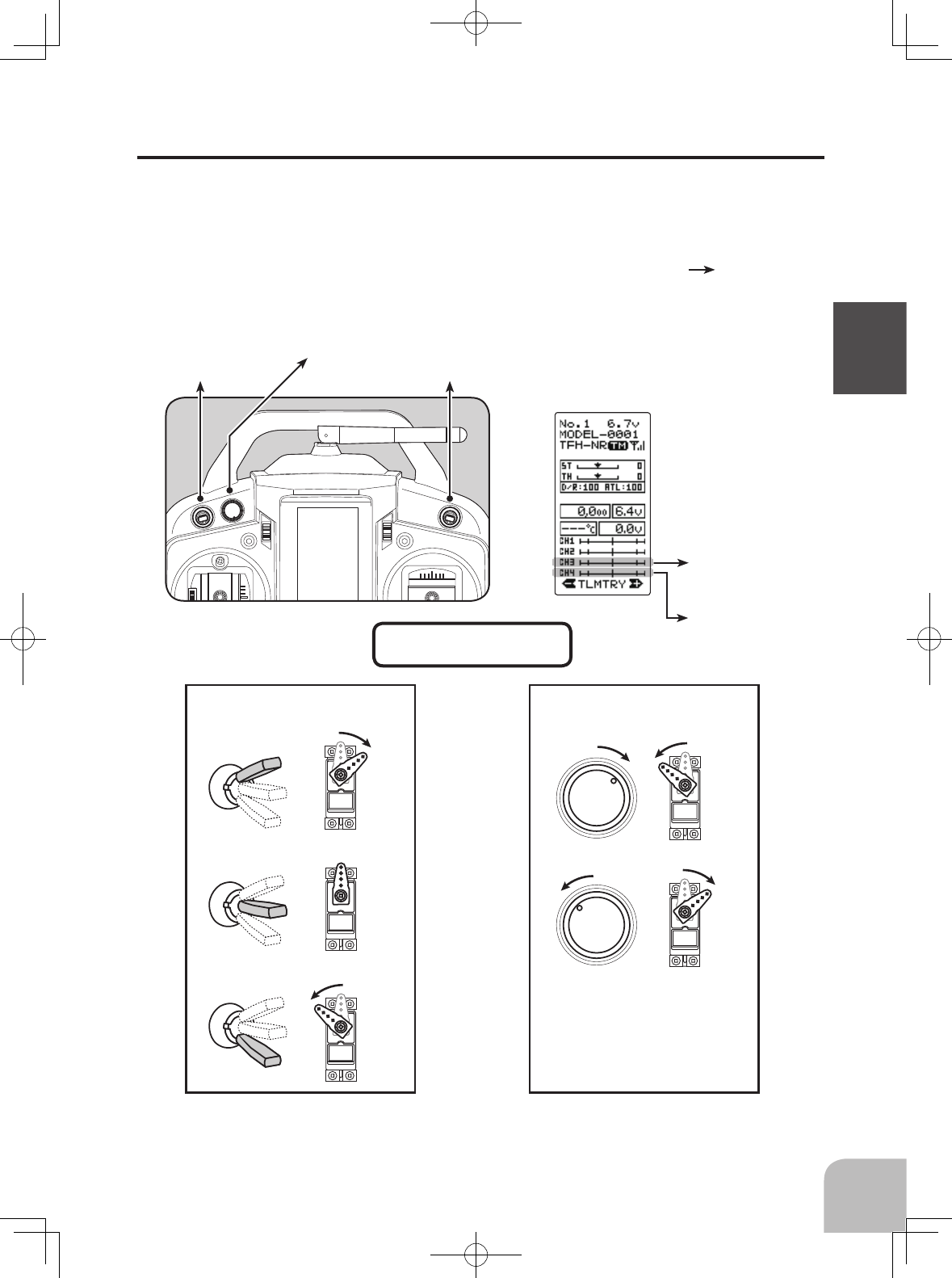
23
Before Using
Operation of CH3 can
be checked.
Operation of CH4 can
be checked.
Switch Dial Operation CH3 CH4
(CH3: Switch SW2, CH4: Dial DL1)
The three-position switch SW2 will result in the servo arm moving to three differ-
ent positions when operated.
Note that this function cannot be assigned to the spring return switch SW1.
Rotating the Dial (DL1) will proportionally control a servo on CH4. T he SW2
switch and DL1 dial can be assigned to either function.
Switch(SW1)The function cannot
be assigned to SW1
•The servo arm position and dial
do not necessarily always match
exactly.
T4GRS beeps when the
dial reaches center and
limit position.
Switch(SW2)
3position Return
SW2 3CH Servo DL1 4CH Servo
Dial(DL1)
Initial setting
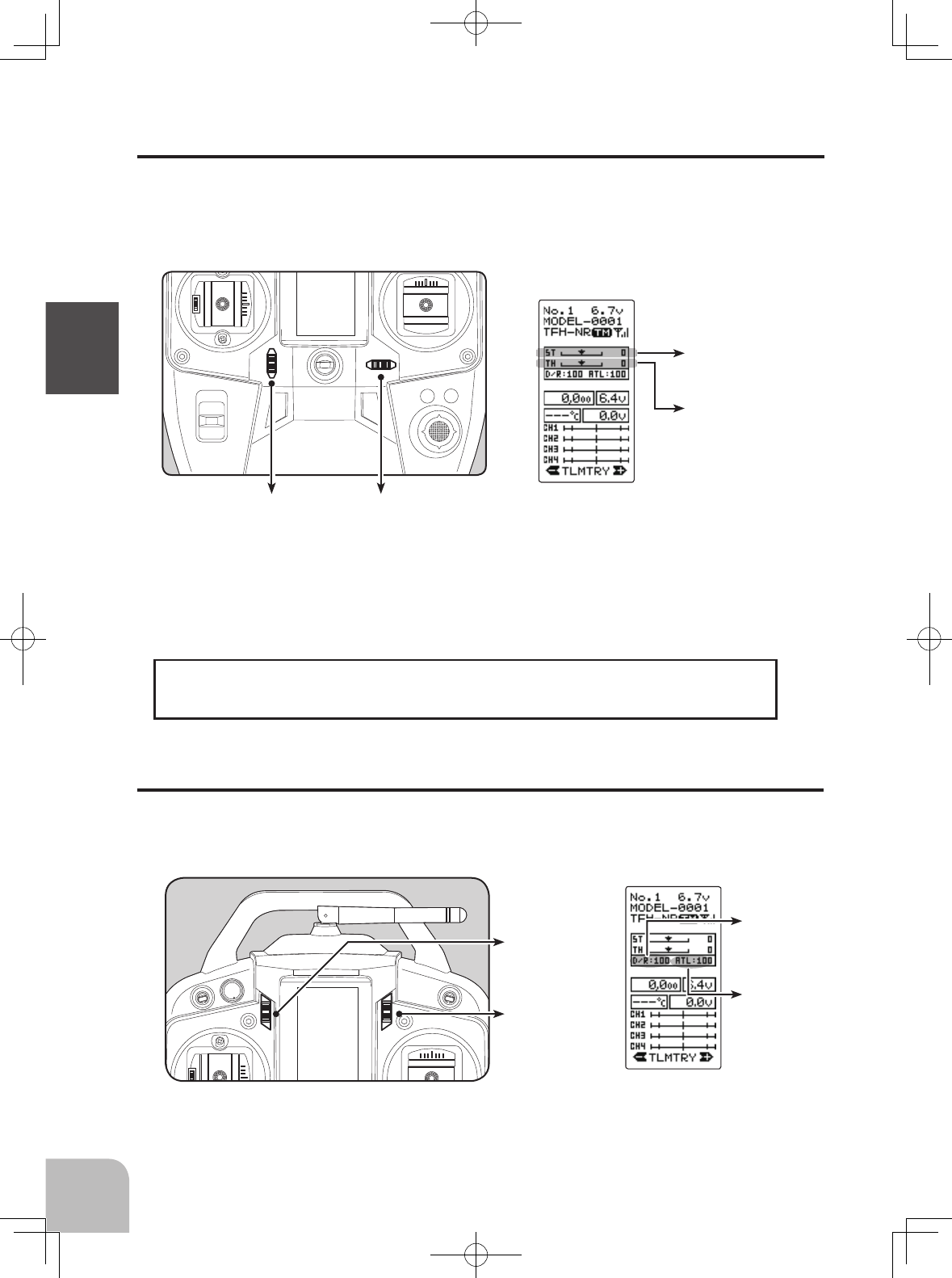
ATL display
Steering D/R
display
Steering trim display
Throttle trim display
DT2 DT1
DT3
Steering
D/R
DT4 ATL
Brake amount
adjustment
24
Before Using
Trim Operation
Digital Trim Operation DT1 DT2
(Initial settings: DT1: Steering trim, DT2: Throttle trim,)
Operated by the lever: Push the lever to the left or right (up or down) The current posi-
tion is displayed on the LCD screen.
• Each step is indicated by a tone.
• When the trim exceeds the maximum trim adjustment range, the beep will change and the servo will not move
any farther.
• Trim lever adjustments have no effect on the maximum servo travel. This prevents the linkages from binding
when adjustments are made.
Digital Trim Operation DT3 DT4
(Initial setting: DT3; Steering D/R, DT4; ATL)
Operated by the lever: Push the lever to up or down. The current position is displayed
on the LCD screen.
• Each step is indicated by a tone.
• When the trim exceeds the maximum trim adjustment range, the tone will change pitch and the servo will not
move any farther.
With the center trim feature, trim adjustments have no effect on the maximum
servo travel. This prevents the linkages from binding when adjustments are made.
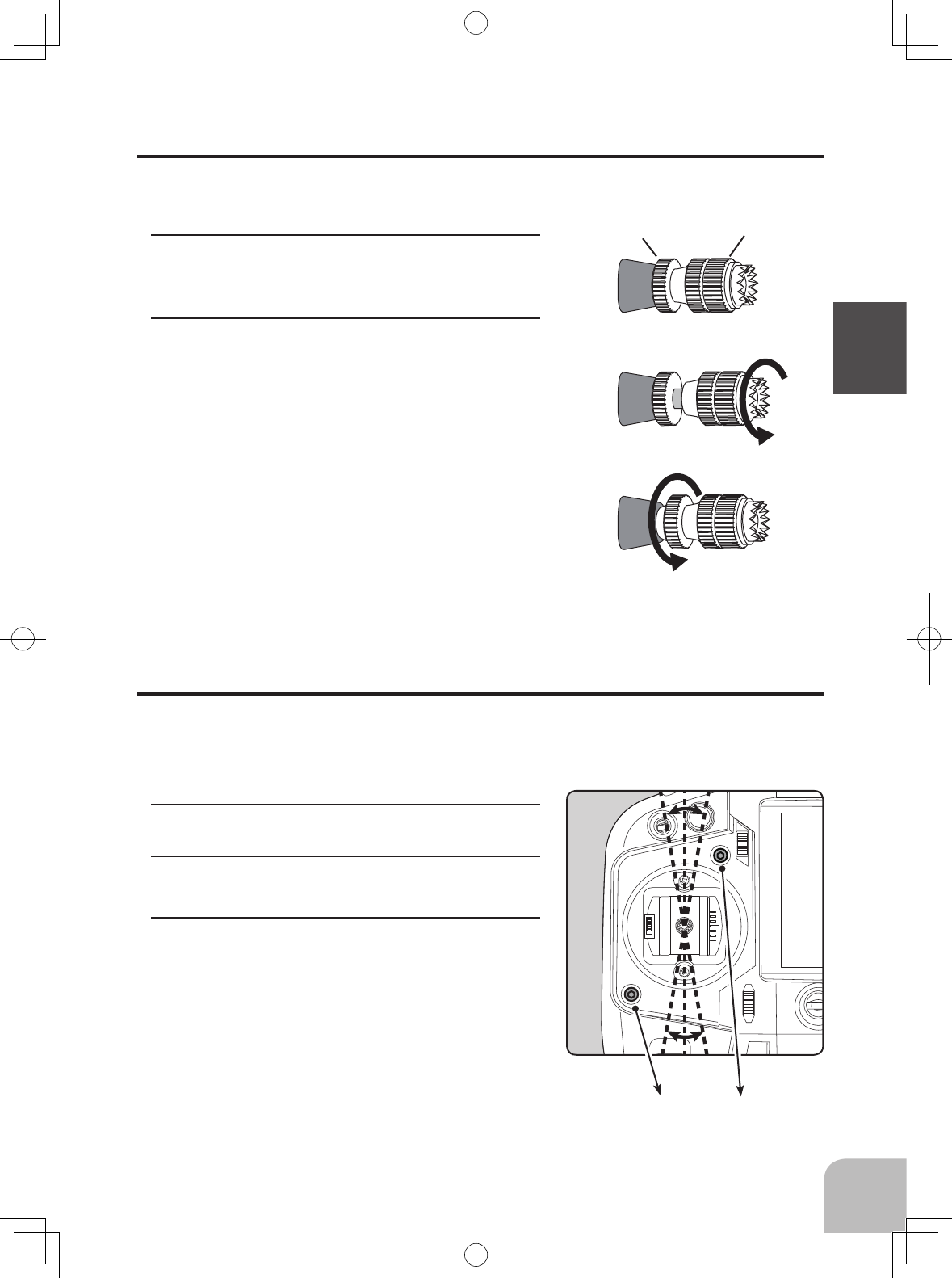
25
Before Using
Lever head B Lever head A
Stick Lever Head Adjustment
The length of the lever head of the steering and throttle sticks can be adjusted.
Adjustment
1Unlock lever head "A" by turning it counterclockwise.
2Adjust the head to the length best for you, then lock the
heads by turning lever head "A" clockwise and lever
head "B" counterclockwise.
Set screws
Stick Mounting Angle Adjustment
The mounting angle of the throttle and steering sticks can be adjusted.
Setting
1Loosen the two set screws.
2Change the stick angle.
3Re tighten the two set screws.
• The figure at the right shows the throttle stick. The steering stick
can adjusted similarly.
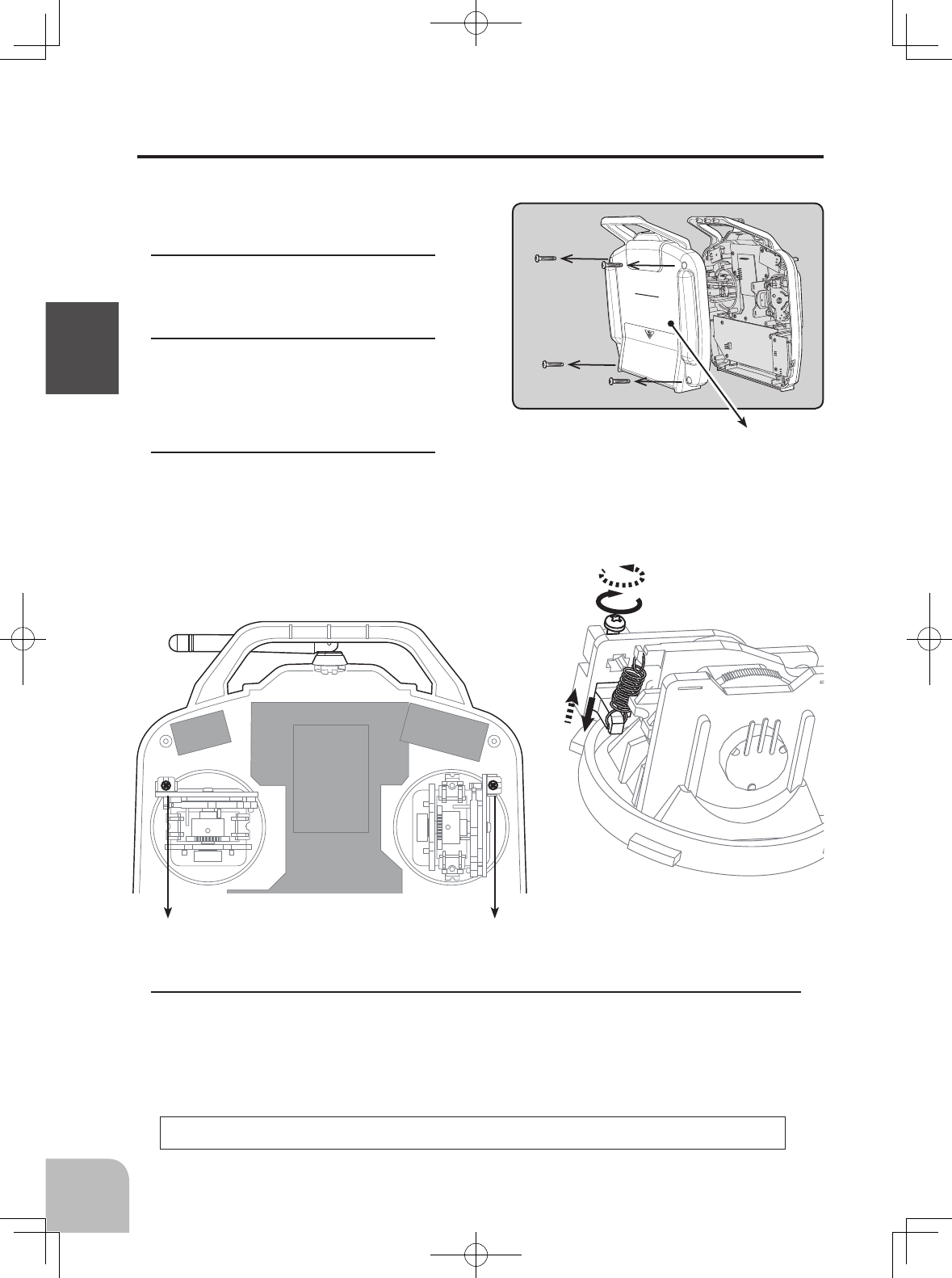
26
Before Using
Steering stick adjusting
screw
Throttle stick adjusting
screw
Stick Tension Adjustment
Make this adjustment when you want to change the steering stick or throttle stick
spring tension.
Adjustment
1Remove the battery from the transmit-
ter.
2Using Phillips screwdriver, as shown in
a figure, four screws are removed, and
a rear case is removed.
• Don't touch internal electronic components.
3Turn the adjusting screw using a small
Phillips screwdriver such as a watch-
maker's screwdriver.
• Turning the adjusting screw clockwise, in-
creases the spring tension.
• The adjustment range is about five turns in
both directions, from the initial position.
4When the adjustment is completed, re-attach the rear case with a Phillips screwdriver.
• Take great care not to damage the wiring when re-attaching the rear case.
• Foreign substances must not be allowed to get into the interior of the case.
Caution
If turned too far counterclockwise, the adjusting screw may fall out.
Rear case
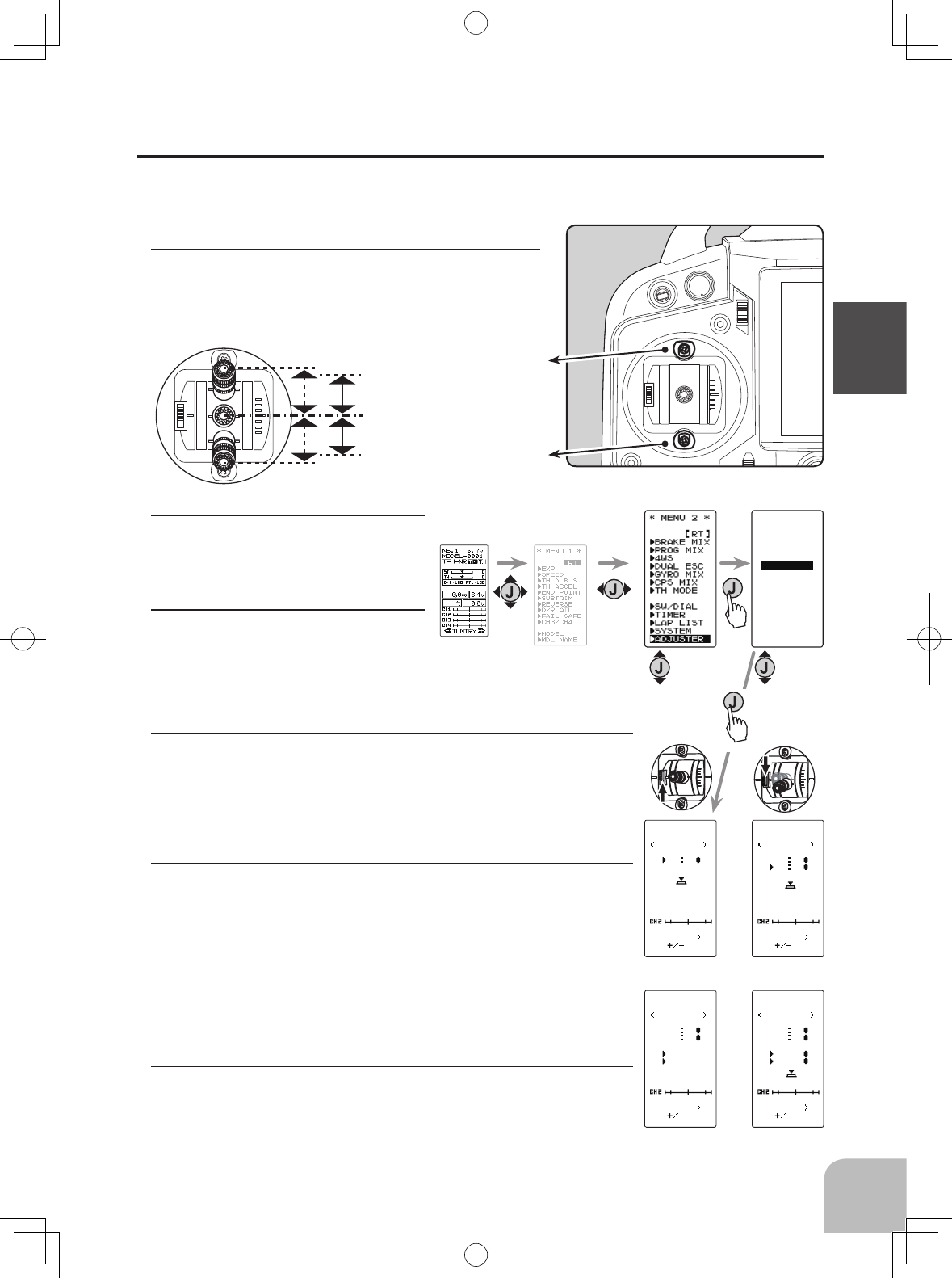
27
Before Using
High side
Brake (reverse) side
Stroke can be reduced mechanically.
Stick stroke adjustment
1Make this adjustment by turning the adjusting screw
above the stick with a Phillips screwdriver.
• When the adjusting screw is turned counter clockwise, the
stroke is reduced.
Mechanical Throttle Stick Stroke Adjustment
Make this adjustment when you want to reduce the throttle stick range at the full
power or brake/reverse positions.
2On the MENU2 screen, select the
setting item "ADJUSTER" using the
(JOG) button, and pressing the (JOG)
button.
3(Selection of THROTTLE)
Move the cursor to "THROTTLE"
using the (JOG) button up or down
function, and pressing the (JOG)
button.
HOME MENU1
Push
ADJUSTER
*STEERING
[ RT ]
*THROTTLE
MENU2
Select
ADJUSTER
Select
THROTTLE
Key
CANCEL
ADJUSTER
THROTTLE
N5 5
Key
CANCEL
ADJUSTER
THROTTLE
N5 5
N7 3
Key
CANCEL
ADJUSTER
THROTTLE
N5 5
N7 3
BRK
FWD
Key
CANCEL
ADJUSTER
THROTTLE
N5 5
N7 3
BRK
FWD
fig-1
fig-3
fig-2
fig-4
4 (Throttle 5:5 neutral adjustment )
Neutral adjuster is set to 5:5 the Neutral Adjuster switch (see
next page). In the 5:5 neutral setup screen (fig-1) state, pull the
stick back slightly then allow to return to neutral and press the
(JOG) button whilst ensuring the stick is not touched.
5 (Throttle 7:3 neutral adjustment )
Neutral adjuster is set to 7:3 by the Neutral Adjuster switch (see
next page). In the 7:3 neutral setup screen (fig-2) state, pull the
stick back slightly then allow to return to neutral and press the
(JOG) button whilst ensuring the stick is not touched.
Note that both the 5:5 and 7:3 neutral adjustment procedures
have to be completed as part of the set-up process. Once com-
plete the required option should be selected.
6 (Throttle throw adjustment)
In the throw setup screen state (fig-3), gently move the stick fully
to the brake /reverse and full power positions and when button
Push
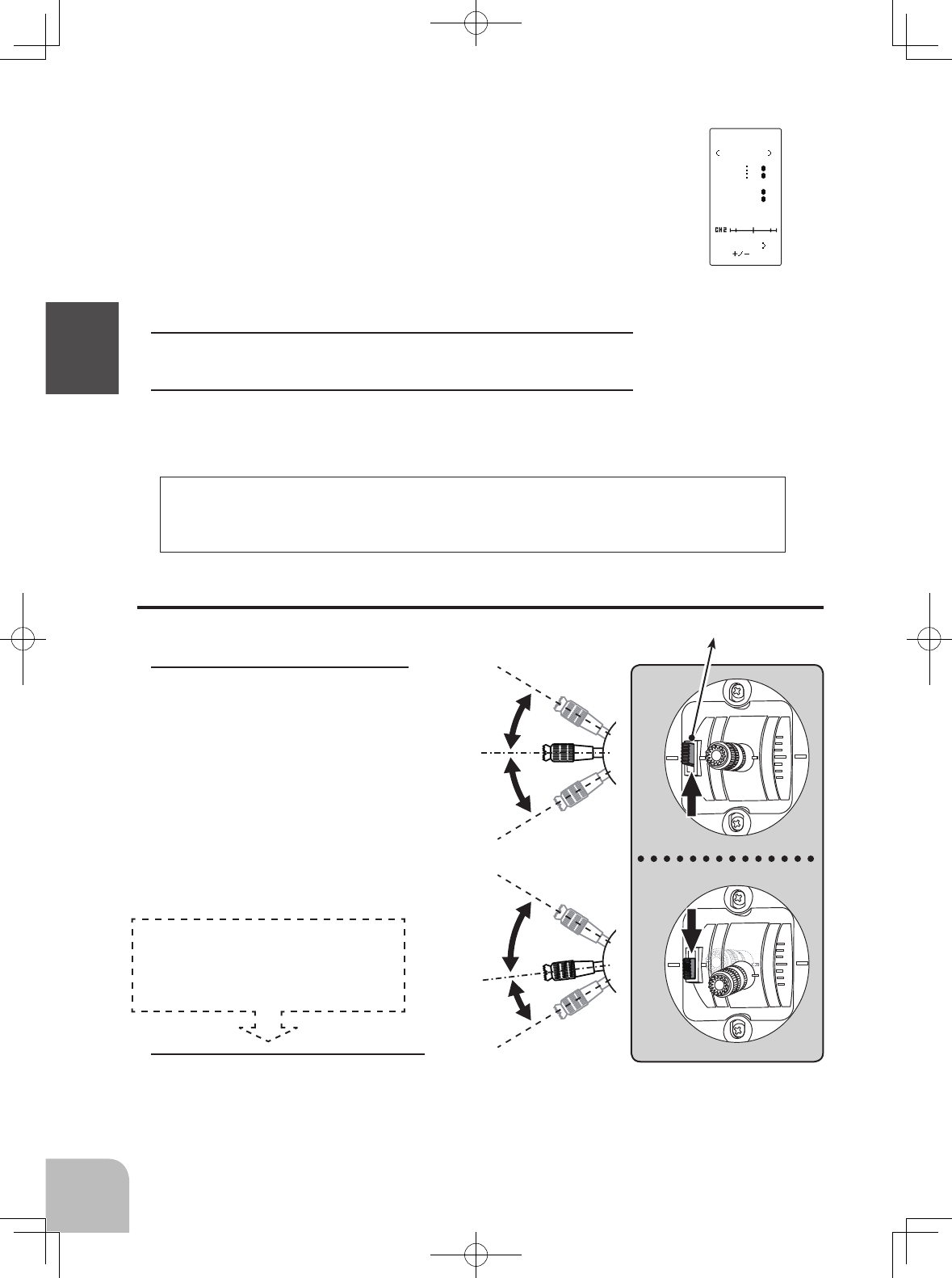
28
Before Using
Neutral Adjuster
Neutral Adjuster Operation
The neutral adjuster selects the throttle stick neutral position.
5
5
7
3
1Neutral adjuster is set to 5 : 5 when
in the upper position. It will be set
to 7 : 3 when moved to the lower
position
• If 7 : 3 is used, the neutral to full power
stick range is increased.
mark (fig-4) is displayed, pressing the (JOG) button.
An internal check is performed automatically. When each adjust-
ment point is within a fixed range, correction is performed and
"COMPLETE!" (fig-5) is displayed.
If an adjustment point is not within a fixed range, correction is
not performed and the correction data is not updated.
If the stroke is made too narrow, this will cause an error.
In that case, extend the stroke.
7When complete, return to the ADJUSTER screen by press the (JOG)
button.
8Next, move the cursor to [RT] by the (JOG) button, and press the (JOG)
button.
Key
CANCEL
ADJUSTER
THROTTLE
N5 5
N7 3
BRK
FWD
COMPLETE!
fig-5
Caution
When the stroke is adjusted, the throttle servo travel should also be adjusted elec-
tronically. If the stroke is mechanically reduced too far the adjusting screw may
fall out.
When a neutral adjuster change
is made, be sure to carry out
system change.
Caution
2On the MENU2 screen, select the set-
ting item "SYSTEM" using the (JOG)
button, and press the (JOG) button.
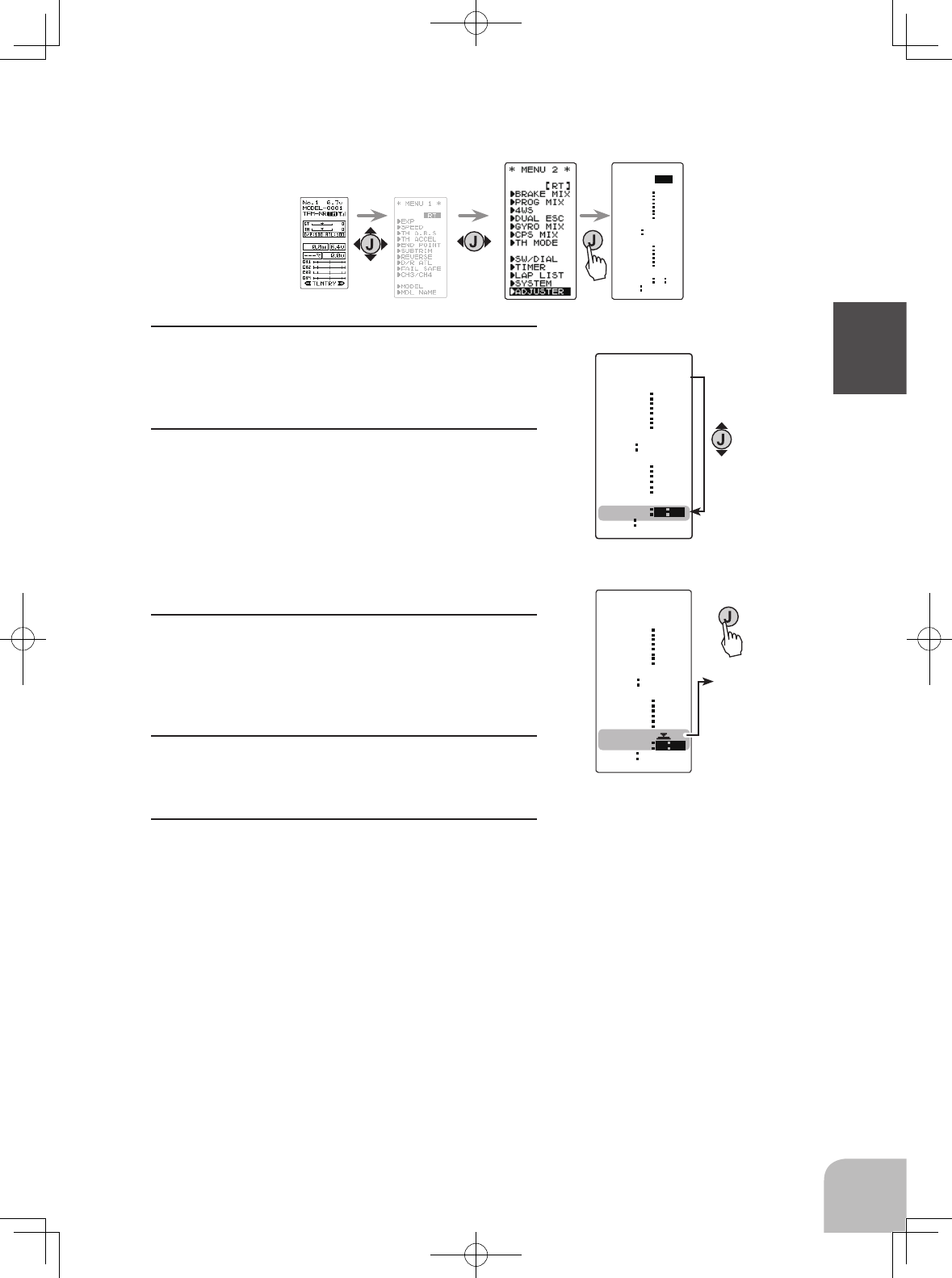
29
Before Using
• "F10" should be selected only when using a ratchet on the
throttle stick. (for GP boats)
UP or DOWN
CONTRA
LHT-TM
BK-LHT
SYSTEM
[ RT ]
LHT-PW
BAT T DRY4
OPE-TM
BUZZER
MENU
TH-STK
DISP
0
ALL
10s
15
65
OFF
TLMTR
ENG
7 3
3(Selection of TH-STK)
Move the cursor to "TH-STK" using the (JOG) but-
ton up or down operation.
4 (Selection of your 4GRS neutral position)
Use the (+) and (-) buttons to select either 5:5 or
7:3.
5(Neutral position execution)
Press the (JOG) button for about 1 second. A beeping
sound is generated and the neutral position is select-
ed.
6When completed, return to the MENU2 screen by
pressing the (JOG) button.
7Next, move the cursor to [RT] using the (JOG) button,
and press the (JOG) button.
HOME MENU1
Push
Push
CONTRA
LHT-TM
BK-LHT
SYSTEM
LHT-PW
BATT DRY4
OPE-TM
BUZZER
MENU
TH-STK
DISP
0
ALL
10s
15
65
OFF
TLMTR
ENG
5 5
RT
CONTRA
LHT-TM
BK-LHT
SYSTEM
[ RT ]
LHT-PW
BAT T DRY4
OPE-TM
BUZZER
MENU
TH-STK
DISP
0
ALL
10s
15
65
OFF
TLMTR
ENG
5 5
MENU2
Press (JOG) about
1second
Selection of your 4GRS
neutral position
5:5
7:3
F10 (Next page)
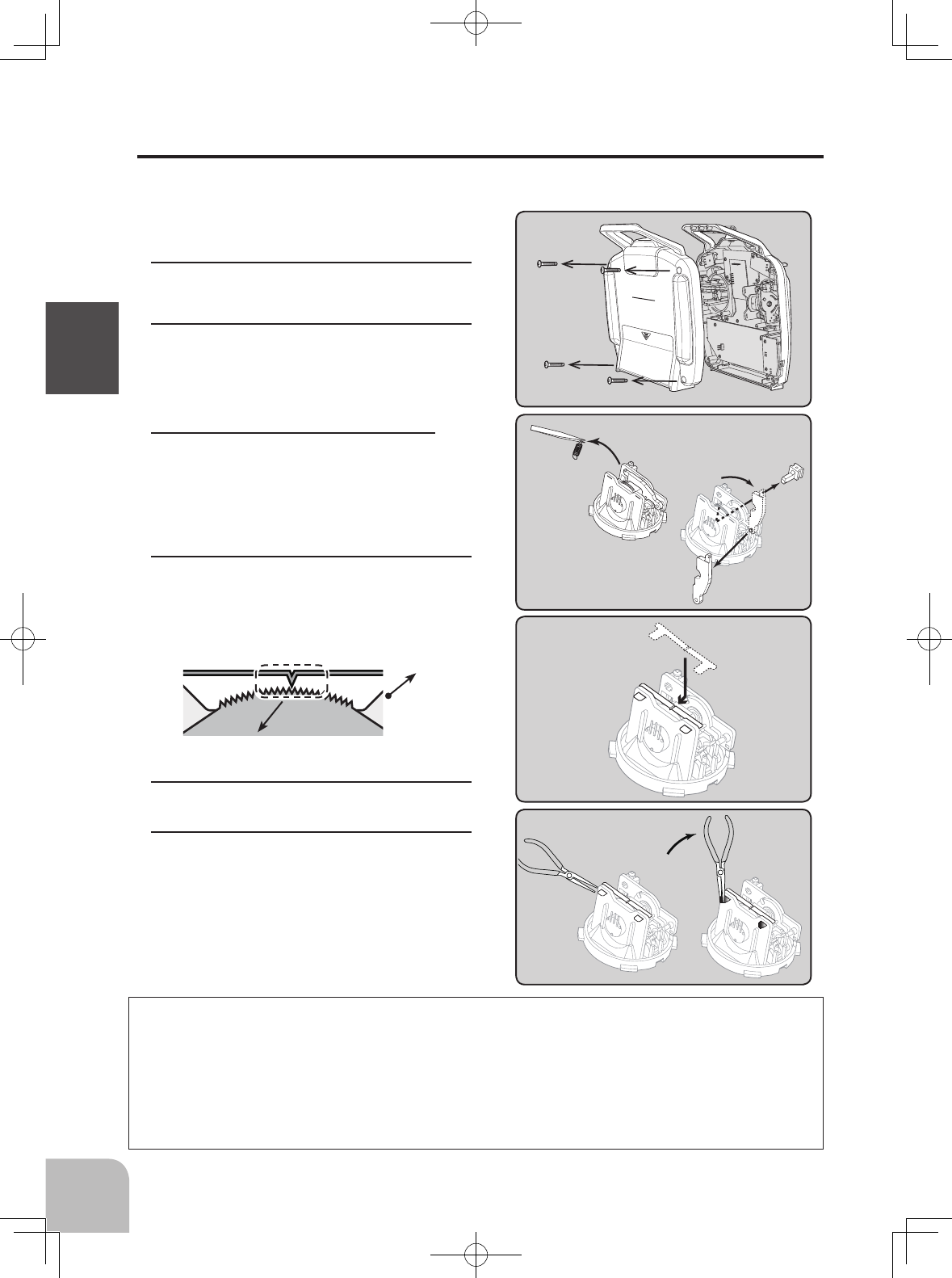
30
Before Using
Changing to Ratchet Type Throttle Stick
Changing the throttle stick from the self-centering type to ratchet type that stops at
an arbitrary position. (To make this modication, the optional ratchet plate must be
pu rchased.)
Adjustment
1Remove the battery from the transmitter.
2Using Phillips screwdriver, as shown in a fig-
ure, four screws are removed, and the rear
case is removed.
• Don't touch internal electronic components.
3Remove the swing arm, spring and
spring hook from the throttle stick as
shown in the figure.
• Retain these parts in case the stick is to be
changed back to self-centering type later.
4Install the ratchet plate to the throttle stick.
5Fasten by twisting the retaining tabs with
needle-nosed pliers.
• The V section of the direc-
tion of a ratchet plate is
downward.
• If the ratchet action is too harsh, a small amount of ser-
vo gear grease should be applied to the ratchet teeth.
Ratchet
plate
Rear case
Spring
Swing
arm
Spring
hook
Ratchet
plate
(Option)
6When the work is completed, re-attach the
rear case using a Phillips screwdriver.
• Take great care not to damage the wiring when re-
attaching the rear case.
• Foreign substances must not be allowed to get into
the interior of the case.
Caution
*If TH-STK is changed to F10 (see previous page), the now unnecessary brake function can be dis-
abled.
*If the throttle stick is not in the stop/idle position when the transmitter is switched "ON" an alarm will
sound. Ensure that the throttle stick is in the stop/idle position when switching "ON" - if the alarm
sounds the throttle output will default to stop/idle.
*The adjustment of the throttle range cannot be carried out if a ratchet is being used, only if the
throttle stick is self-centering.
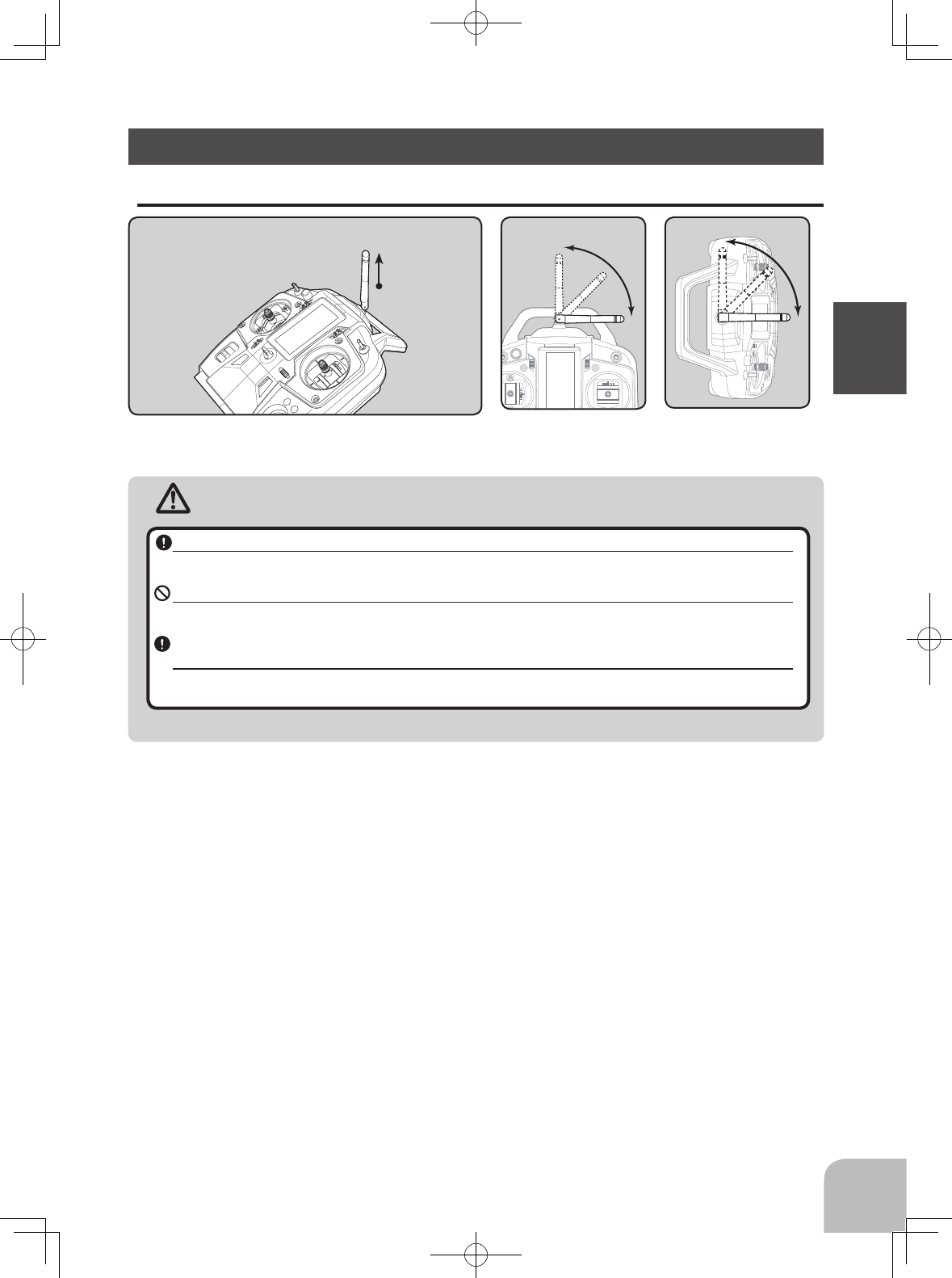
31
Before Using
Warning
Antenna Moving Range
Position the antenna vertically
to the ground.
Antenna
A B
About The Transmitter Antenna
Position the antenna vertically to the ground.
In other positions the operating range may be reduced.
Never hold only the antenna.
Hold the grip handle. Otherwise, the antenna may be damaged.
The antenna position can be changed in the range as shown in figures A and B. However, please
do not apply unnecessary force or shock.
The internal cable may be damaged; thus transmitting distance is reduced and this may result in faulty operation.
About Transmitter Antenna and Receiver
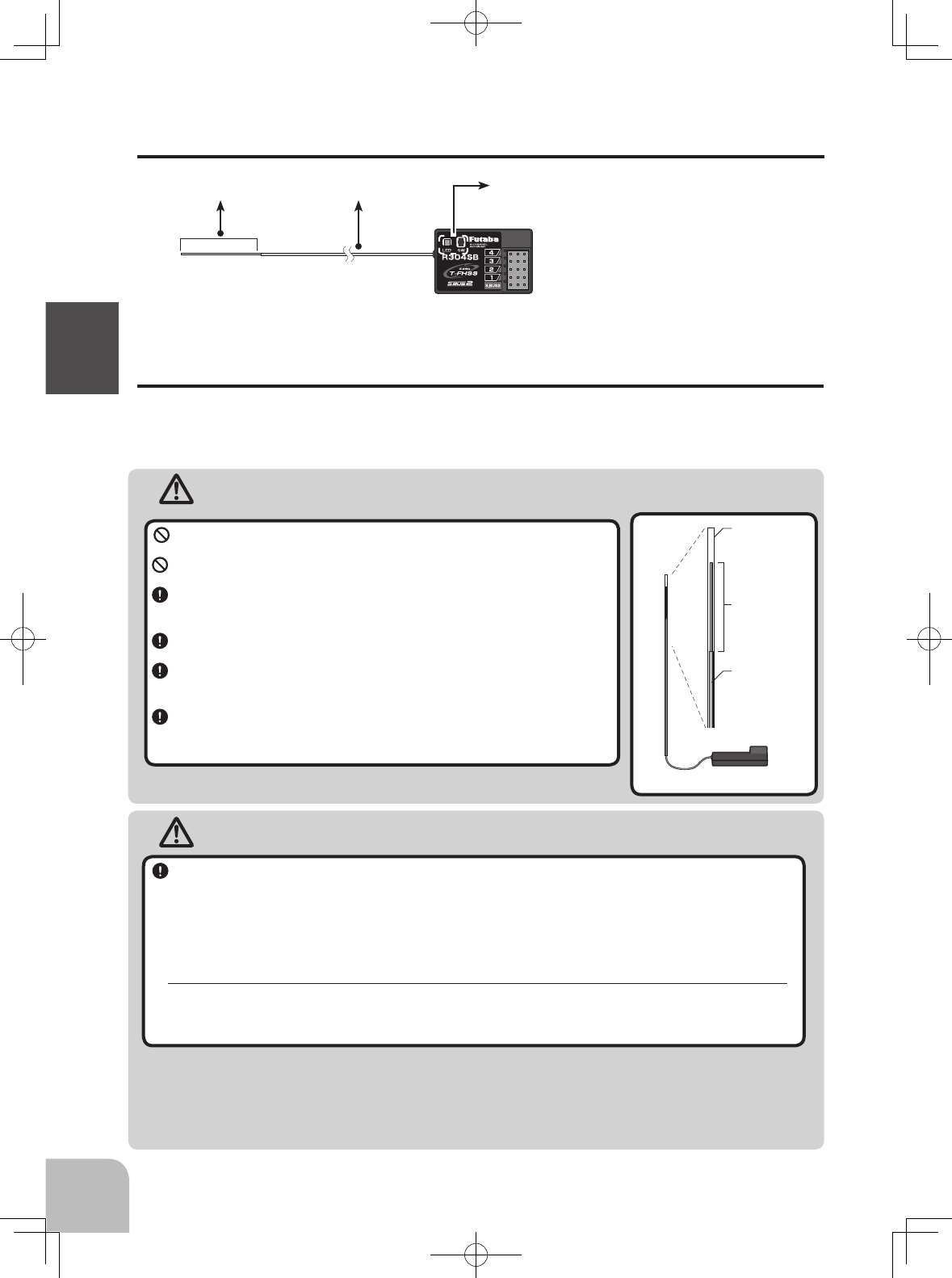
WARNING
Caution
Antenna
tube
Antenna
Coaxial
cable
R304SB
32
Before Using
Always use R304SB,R304SB-E under the following conditions:
Battery :Power requirement Rated voltage 4.8~7.4V (dry cell battery cannot be used)
Matched to the ratings of the receiver and connected servo.
RX MODE :"T-FHSS(HIGH)" or "T-FHSS(NORM)"
Transmitter mode-"T-FHSS(HIGH)" mode :Futaba digital servo
Transmitter mode-"T-FHSS(NORM)" mode :Futaba all servo
Under other conditions, the set will not operate, or the specified performance will not be displayed even if it operates. In
addition, it may cause trouble with servos and other equipment. Futaba will not be responsible for damage, etc. caused
by combination with the products of other companies.
Receiver Installation
Install the R304SB receiver on the car as follows:
The operating range may reduced, depcompleted on where the receiver and the antenna
are mounted.
Do not cut or bundle the receiver antenna wire.
Do not bend the coaxial cable. It causes damage.
Install the antenna in the highest position possible as shown in the
figure.
Put the antenna in the antenna tube to protect it.
Keep the antenna as far away from the motor, ESC and other noise
sources as you possibly can.
Wrap the receiver with something soft, such as foam rubber, to
avoid vibration. If there is a chance of getting wet, put the receiver in
a waterproof bag or balloon.
Transmitter mode setting
Set the transmitter to the "T-FHSS(HIGH)" mode or "T-FHSS(NORM)" mode.
Note: Only digital servos (including BLS Series Brushless servos) can be used in the T-FHSS(HIGH) mode.
Receiver Terminology
Antenna Coaxial cable Link switch/LED
Connectors
4 :CH4 servo(CH4)
3 :CH3 servo(CH3)
2 :Throttle servo(CH2)
1 :Steering servo(CH1)
S.BUS2 :
Power /S.BUS2 connector
The receiver power supply can be connected
to the S-BUS2 connector or any of CH1-4.
*R304SB-E(for EP Car) has built-in antenna.
R304SB
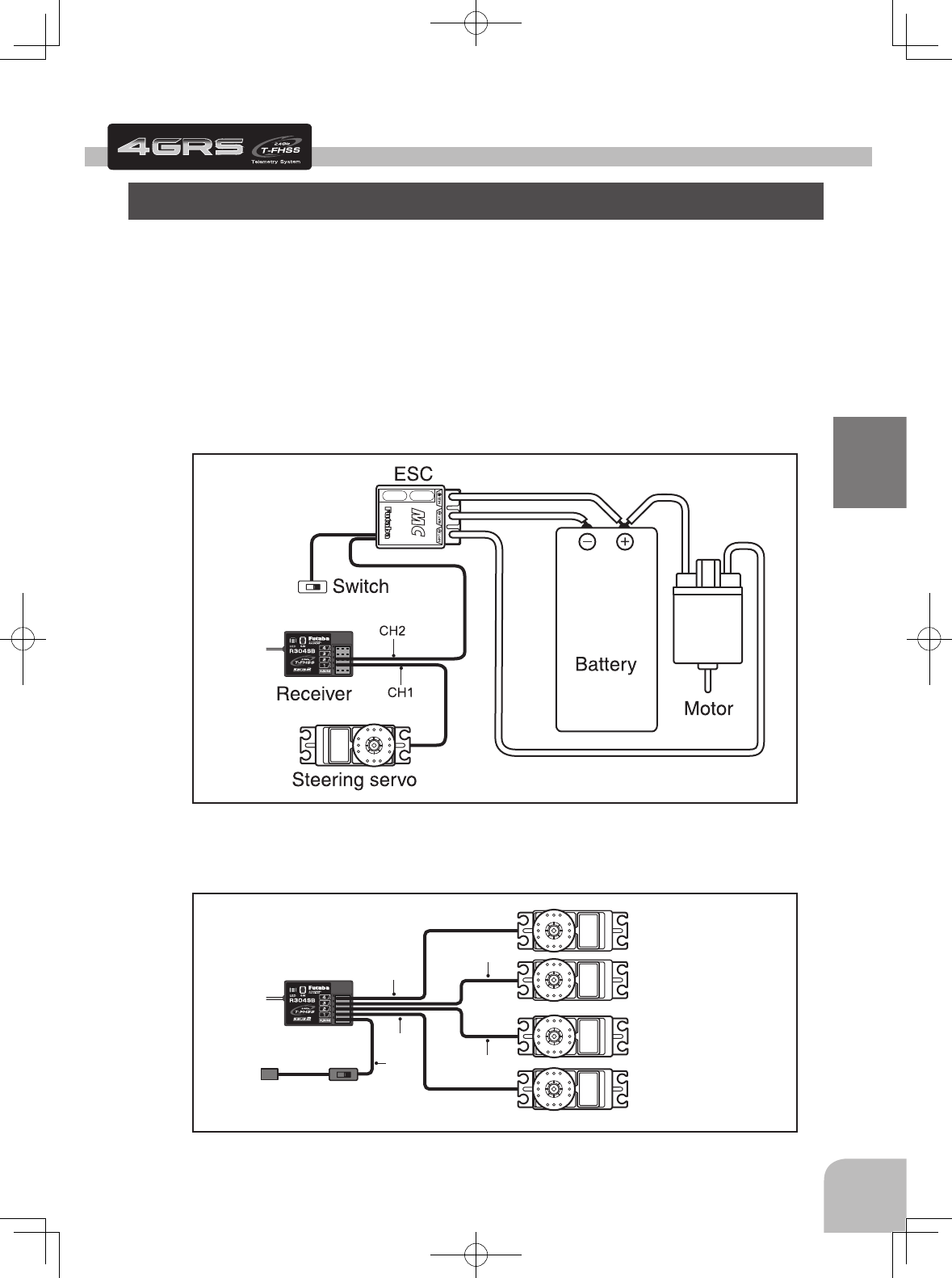
B/C
CH3
CH2
CH1
CH4
Receiver
Switch
To Battery Steering servo
Throttle servo
CH3 servo
CH4 servo
33
Installation
Connect the receiver and servos as shown below. Connect and install the receiver and
servos in accordance with "Installation Safety Precautions" on the next page.
The gure shown below is an example. The method of connecting the motor controller
to the motor and battery depends on the motor controller used. Purchase the motor con-
troller and servos separately. The receiver also depends on the set.
Installation When An Electronic Speed Control Is Used
Installation For Gas Powered Models
Installation
Receiver and Servo Connections
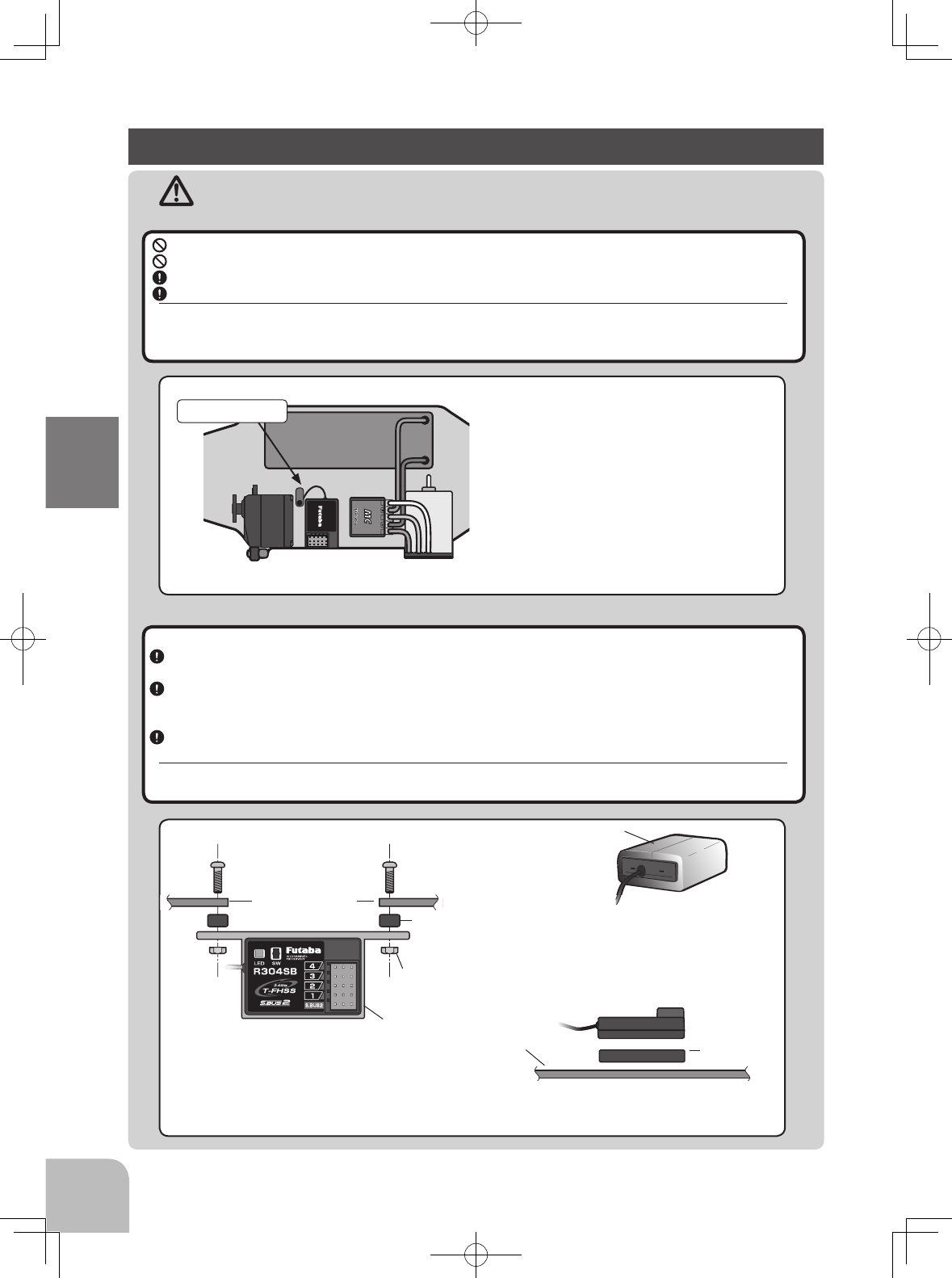
Installation Safety Precautions
Warning
34
Installation
Receiver (receiver antenna)
Receiver vibration-proofing / waterproofing
Do not cut or bundle the receiver antenna wire.
Do not bundle the receiver antenna wire together with the motor controller lead wire.
Keep the receiver antenna wire at least 1cm away from motor, battery, and other wiring carrying heavy current.
Install the receiver antenna holder as closely as possible to the receiver.
If the antenna wire is cut, bundled, or routed near a noise source, the receiving sensitivity will drop, the running (sailing)
range will decrease, and you may lose control of the model.
*Noise is transmitted through metal, carbon, and other conductive material, so keep the receiver antenna wire away from such parts.
(Car)
Vibration-proof the receiver by wrapping it in foam rubber or other vibration-absorbing material
and mount it with thick double-sided tape.
When using the receiver holder supplied with the model kit, mount the holder to the chassis
through a rubber grommet.
(Boat)
Vibration-proof the receiver by wrapping it in foam rubber or other vibration-absorbing material.
Also waterproof the receiver by sealing it in a plastic bag.
If the receiver is exposed to strong vibration and shock, or suffers from water leakage, reliable operation may be lost and
you may lose control of the model.
Screw
Mechanical plate
Nut (as required)
Receiver holder
Damper
When using the receiver holder sup-
plied with the kit, install the receiver
holder using rubber grommets to re-
duce vibration.
Foam rubber, etc.
Wrap the receiver in foam rubber or oth-
er vibration-absorbing material. Do not
use hard material. Hard material does not
have a vibration-proong effect.
Mechanical plate Thick double-
sided tape
When mounting the receiver with double-sided tape,
do not use a stiff tape. Stiff tape does not have a vibra-
tion-proong effect.
#%$
Antenna
Install the receiver as far away as possible from the
battery, motor controller, motor, silicon cord and
other noise sources. Keep it away from the antenna
wire, in particular.
Battery
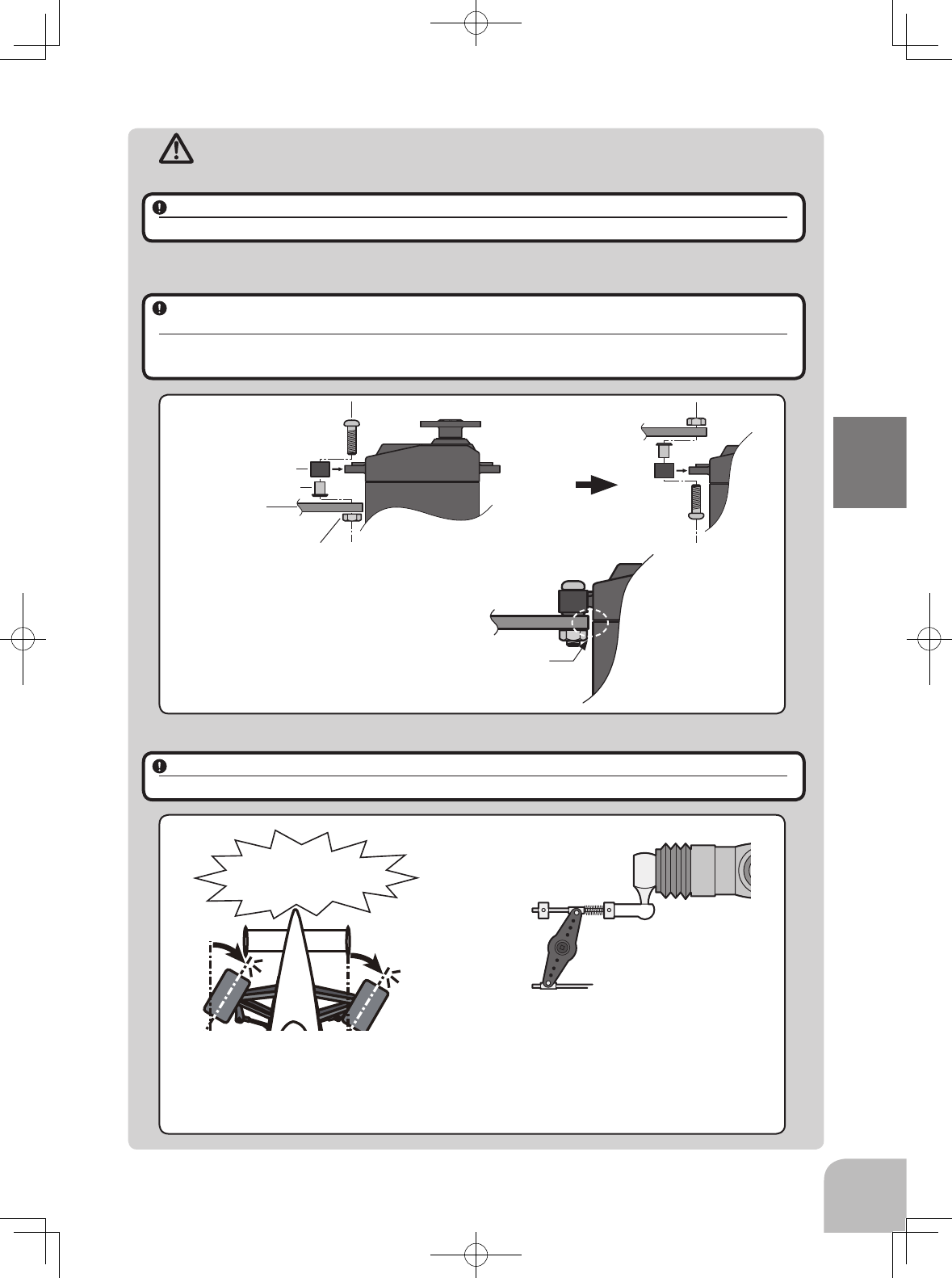
Warning
35
Installation
Connector Connections
Servo Installation
Be sure the receiver, servo, battery and connectors are fully and firmly connected.
If vibration from the model causes a connector to work loose while the model is in operation, you may lose control .
When you install the servos, always use the rubber grommets provided in servo hardware bags.
Mount the servos so they do not directly come in contact with the mount.
If the servo case comes in direct contact with the mount, vibration will be directly transmitted to the servo.
If this condition continues for a long time, the servo may be damaged and control will be lost.
Servo Throw
Operate each servo over its full stroke and be sure the linkage does not bind or is loose.
The continuous application of unreasonable force to a servo may cause damage and excessive battery drain.
Screw
Mechanical plate
Nut (as required)
Eyelet
Damper
(or)
When installing the servo, always install the accessory
rubber grommet and grommet ush against the servo.
A vibration-damping effect is not obtained if
the rubber grommet and grommet are not in-
stalled correctly.
Adjust the throttle servo so that excessive force is not
applied when the engine carburetor is fully open, fully
closed, and the brakes are applied fully.
If the brakes overheat while running, their ability to
function properly decreases. Before running, adjust the
suitable maximum servo travel so that excessive force
is not applied even when the servo travel is increased
while running.
Adjust the steering servo so that excessive
force is not applied to the servo by the chas-
sis at maximum servo travel.
Decide the EPA value at the
contact point.
Caution!
A whining noise indicates that the
steering servo is improperly set.
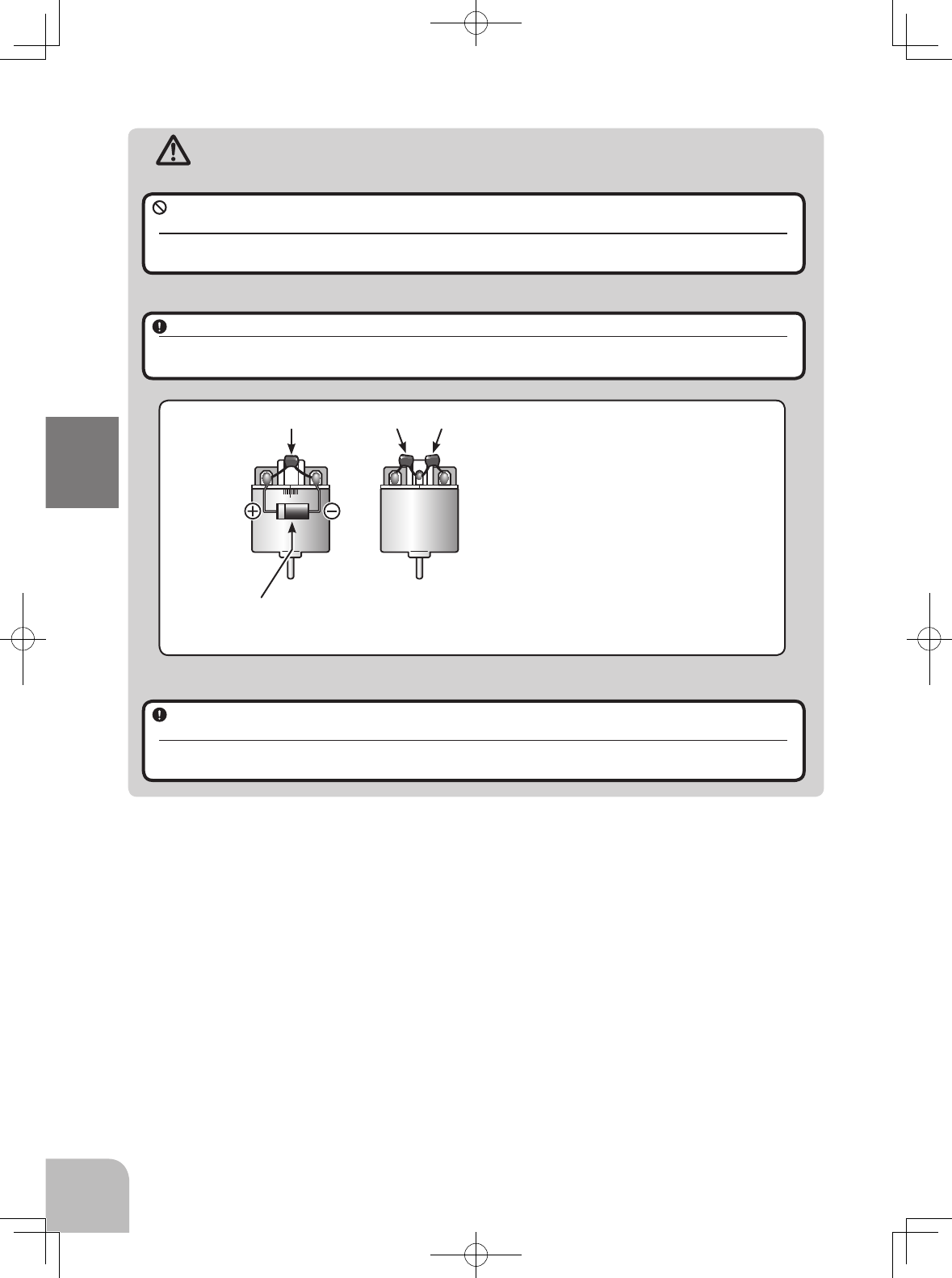
Warning
36
Installation
Electronic Speed Control
Motor Noise Suppression
Install the heat sinks where they will not come in contact with aluminum, carbon fiber or other
parts that conduct electricity.
If the FET Amp (Electronic speed control) heat sinks touch other materials that conduct electricity a short circuit could
occur. This could result in loss of control and damage to the system.
Always install capacitors to suppress noise when electric motors are used.
If capacitors are not properly installed you could experience erratic operation and reduced range as well as loss of con-
trol.
Other Noise Suppression Methods
Be sure there are no metal parts in your model which under vibration can come in contact with
other metal parts.
Metal to metal contacts under vibration will emit a high frequency noise that will affect the receiver's performance. You
could experience erratic operation and reduced range as well as loss of control.
Motors with no suppressor capacitors, or inade-
quate suppression, may cause the receiver to mal-
function. Always solder the capacitors supplied to
your motor.
The Schottky diode improves the efciency of the
speed control / motor combination and provides
extra protection to the brake FETs. The white ring
must always face the positive side.
Schottky diode
"-" side
"+" side
1 2 3
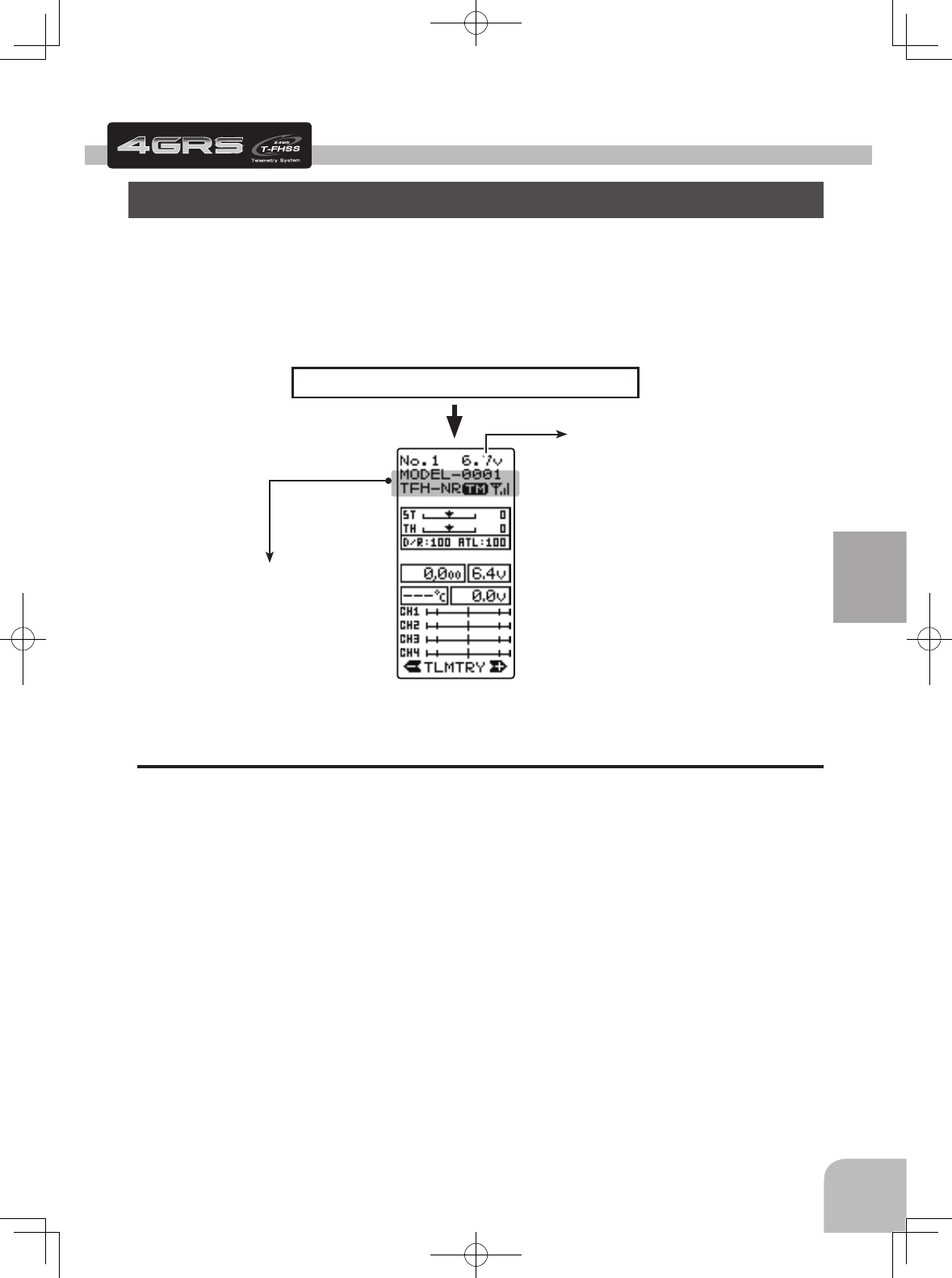
37
Initial Set-Up
Before setting the Transmitter functions, check set the following items rst.
Initial Set-Up
Preparations (Transmitter)
(Display when power switch turned on)
When the power switch is turned on, the currently selected model number is displayed.
Check if this number is the model number you want to set-up. To change the model
number, use the Model Select function.
(HOME screen)
Turn on the transmitter power.
The model number is
displayed.
The battery voltage is
displayed.
Receiver Type Check (RX MODE)
This mode sets the RX type of the transmitter to match the receiver and servos used.
The T4GRS transmitter uses the telemetry type T-FHSS ("TFH") system.
It can also use the conventional FHSS and S-FHSS ("SFH") systems. Because the
R304SB(-E) receiver supplied with the T4GRS uses the telemetry type T-FHSS ("TFH")
system, its RX type must be set to the T-FHSS high speed mode ("TFH-HI") or the T-
FHSS normal mode ("TFH-NR"). Never use analog servos when the RX type was set to
the T-FHSS ("TFH") 2.4GHZ system high speed mode "TFH-HI" or the S-FHSS (SFH)
high speed mode "SFH-HI". The servos may be damaged. For example, if analog ser-
vos are used with a telemetry type T-FHSS receiver (R304SB, etc.), the RX type must
be set to "TFH-NR", and if analog servos are used with an S-FHSS receiver (R2104GF,
R204FG-E, etc.), the RX type must be set to S-FHSS ("SFH-NR") system normal mode
or FHSS ("FHSS") system. When using digital servos (including BLS Series brushless
servos), any RX type can be used.
When a dedicated FHSS receiver (R603GF/R2004GF) is used, it will not operate if the
RX type is not set to "FHSS".
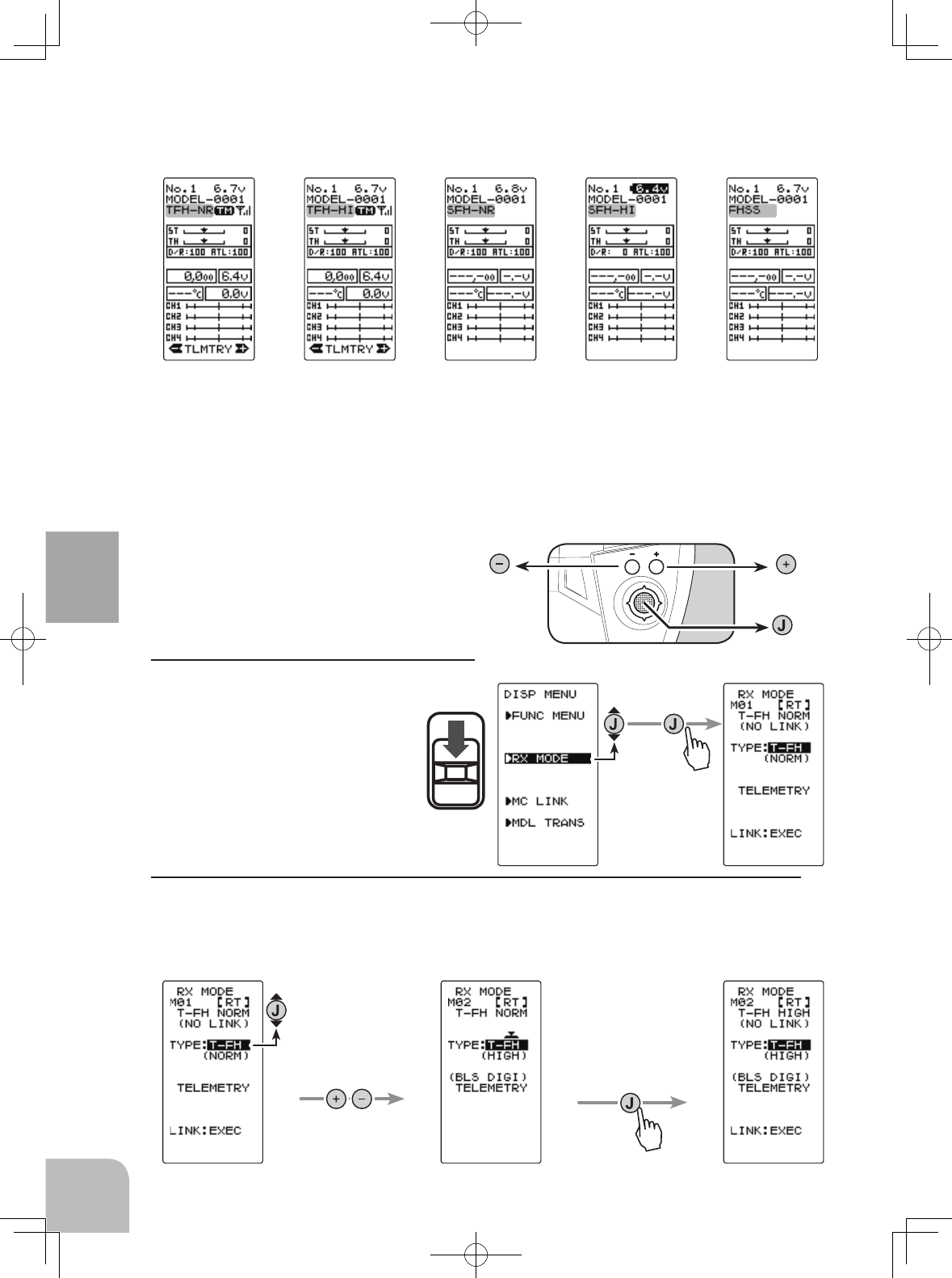
FHSS T-FHSS Normal speed
T-FH (NORM)
S-FHSS Normal speed
S-FH (NORM)
T-FHSS High speed
T-FH (HIGH)
S-FHSS High speed
S-FH (HIGH)
Push
Select "RX MODE"
by (JOG) button.
Push
Select TYPE with
the (+) or (-) but-
ton.
Select RX type with the (+)
or (-) button.
Press the (JOG) buttons
continuously for approxi-
mately 1 second.
(+) button (-) button
(JOG) button
DISP
DOWN
38
Initial Set-Up
If the receiver used and the RX type settings are different, change the RX type using
the "RX MODE" function. Which RX type is set can be checked at the HOME screen.
Receiver Type Change & How To Link
The rst operation described below sets the RX type. Next, the transmitter and receiver
are linked and the transmitter ID number is memorized at the receiver so that signals
from other transmitters will not be received. The telemetry type T-FHSS also simultane-
ously memorizes the ID number of the receiver at the transmitter so that data from other
receivers will not be received.
The RX type setting and transmitter and
receiver linking methods are described
here. Refer to the figure at the right for
the edit buttons used.
1Set the transmitter
power switch to DISP.
Select "RX Setting"
using (JOG) button
up or down opera-
tion, and display the
"RX MODE" screen
by pressing the (JOG)
button.
2Move the cursor to "TYPE: ----" using (JOG) button up or down operation, and select the
RX type with the (+) button or (-) button.
When the (JOG) button is pressed for approximately 1 second, an electronic sound is
generated and setting ends.
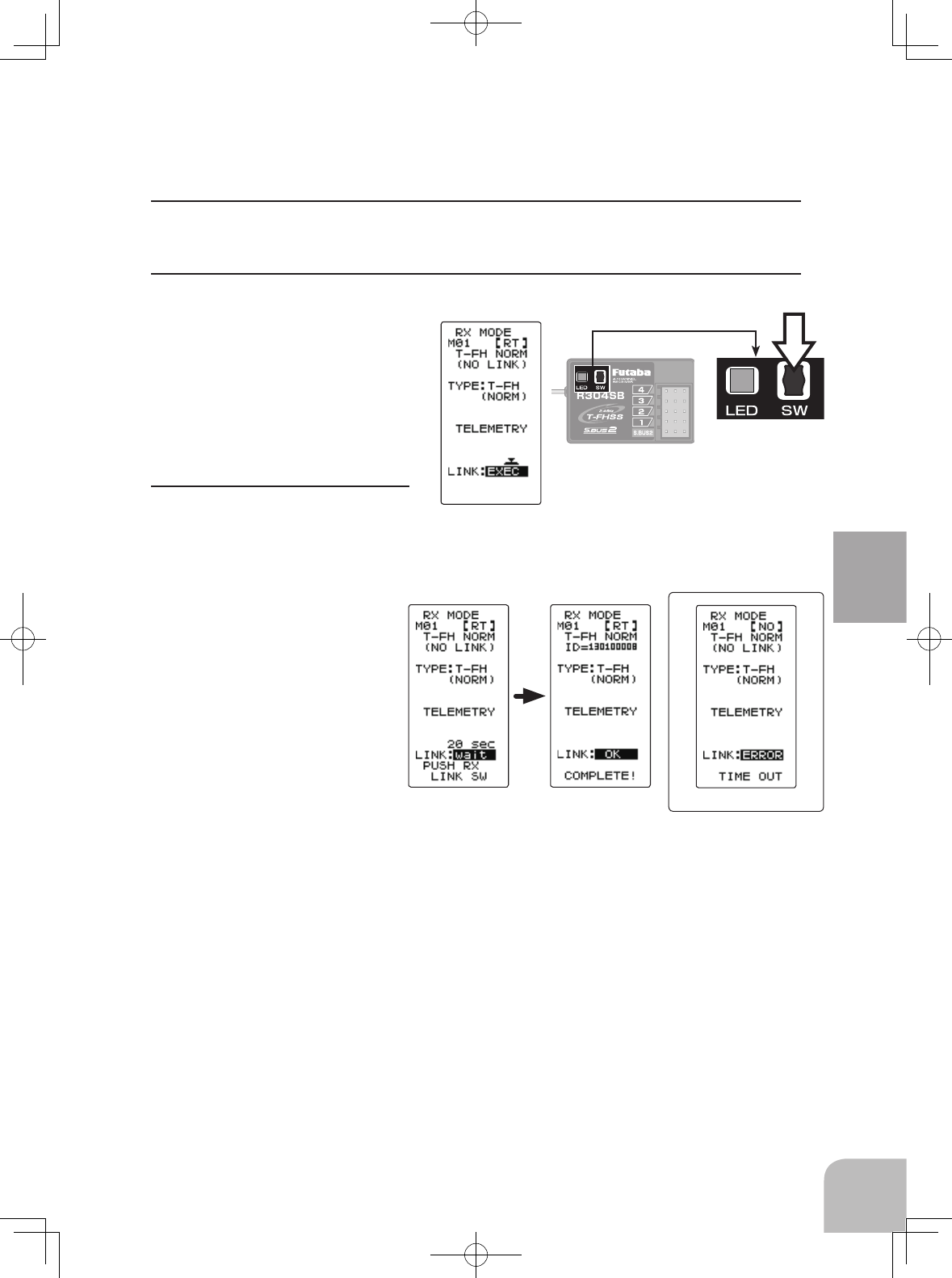
R304SB
(Error screen)
39
Initial Set-Up
*When using an FHSS (R603GF/R2004F, etc.) or S-FHSS(SFH) system (R2104GF,
R204GF-E, etc.) receiver, after the end of setting up to here set the transmitter power
switch to OFF and go to "Receivers other than T-FHSS" .
3Bring the transmitter and receiver to within 50cm of each other (do not allow the anten-
nae to touch) and turn on the receiver power.
4Move the cursor to "LINK: EXE" by (JOG) button up or down operation.
When the (JOG) button is pressed
for approximately 1 second, "PUSH
RX LINK SW" appears on the
screen and 20 seconds countdown
begins. Countdown can be can-
celled at any time using button up
down or left right operation.
5During 20 seconds countdown,
press the receiver link switch for approximately 2 seconds. The LED will begin to blink
red. After the receiver LED switches from blinking red to green-red steady light, the
T4GRS generates an electronic beeping sound, and "LINK:OK" and "COMPLETE!" ap-
pear on the screen, reading of
the mutual IDs ends and the
memorized receiver ID num-
ber appears on the T4GRS
screen. If an error screen was
displayed, linking failed. Retry
linking. If the transmitter and re-
ceiver are linked normally, set
the power switch to the OFF
position and then return it to
the PWR ON position. If the receiver LED lights green, linking was successful. Check for
correct servo operation.
*The T4GRS and a telemetry type T-FHSS receiver (R304SB, etc.) mutually memorize
the combined ID linked last at each model memory.
Since the T4GRS can memorize only 1 receiver ID at each model memory, multiple T-
FHSS receivers cannot be used with the same model memory. If the same model mem-
ory is used for more than one model it will be necessary to re-link the receiver’s each
time a different model is operated.
When using multiple telemetry type T-FHSS receivers, link and combine them with each
T4GRS model memory.
Note however that, multiple receivers cannot be linked to multiple model memories.
The telemetry function communications status can be checked at the T4GRS HOME
screen.
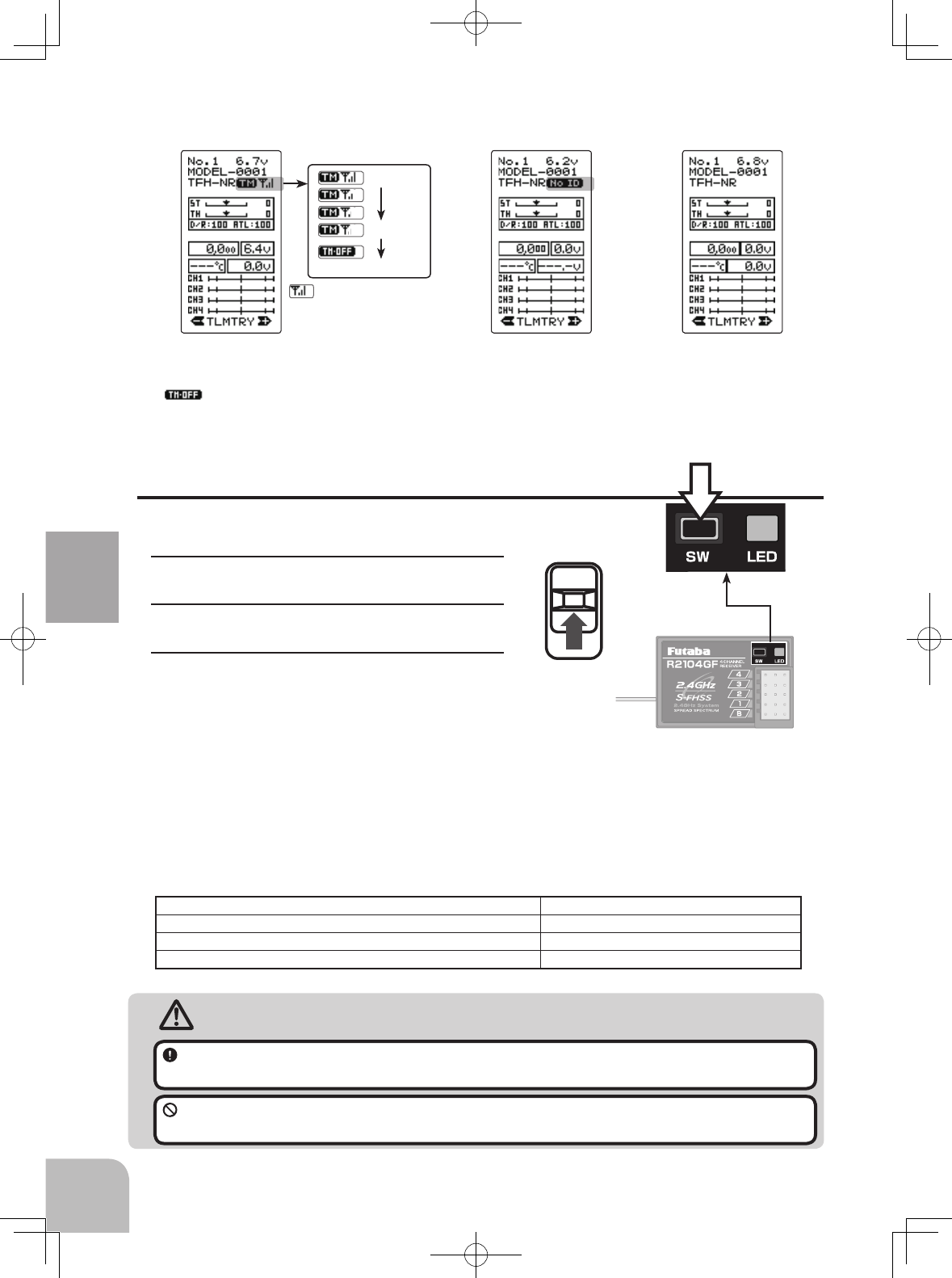
Telemetry function :OFF- Telemetry function :ON
- Receiver ID before setting or ID mis-
match
- When the receiver ID is set, before
ID check in the receiver power OFF
state.
- Telemetry function :ON
- Receiver ID setting complete
- Data receiving sensitivity display
- shows that data cannot be re-
ceived because it is outside the data re-
ceiving range or because of the effects
of an obstruction or the receiver power is
OFF after receiver ID check.
The reception strength
No signal reception
High
Low
Receiver -> Transmitter:
The reception strength is shown.
40
Initial Set-Up
Receivers Other Than T-FHSS
1Bring the transmitter and the receiver close to each other,
within 20 inches (half meter).
2Turn on the transmitter.
3Turn on the receiver.
4Push the link switch of the receiver.
When the link is complete, the LED in the receiver changes
to solid green.
Precaution:
If there are many Futaba 2.4GHz systems (T-FHSS/ S-FHSS/ FHSS) turned on in close proximity to your re-
ceiver then it might not link to your transmitter. In this case, even if the receiver’s LED stays solid green, unfor-
tunately the receiver might have established a link to one of other transmitters. This is very dangerous if you do
not notice this situation. In order to avoid the problem, we strongly recommend you to double-check whether
your receiver is really under control by your transmitter by giving the stick input and then checking the servo
response.
*Please refer to the table below for LED status vs receiver's condition.
LED status vs receiver’s condition:
Warning
After the linking is done, please cycle receiver power and check if the receiver to be linked is re-
ally under the control of your transmitter.
Do not perform the linking procedure with the drive motor connected or the engine operating as it
may result in serious injury.
The telemetry ON/OFF and communication status can be checked at the HOME screen.
No signal reception Red : On
Receiving signals Green: On
Receiving signals, but ID is unmatched. Green: Blink *1 (T-FHSS ,Red : On)
Unrecoverable failure (EEPROM,etc.) LED: Red and Green turn on alternately
*1: LED could be change to red intermittently during data processing.
UP
ON
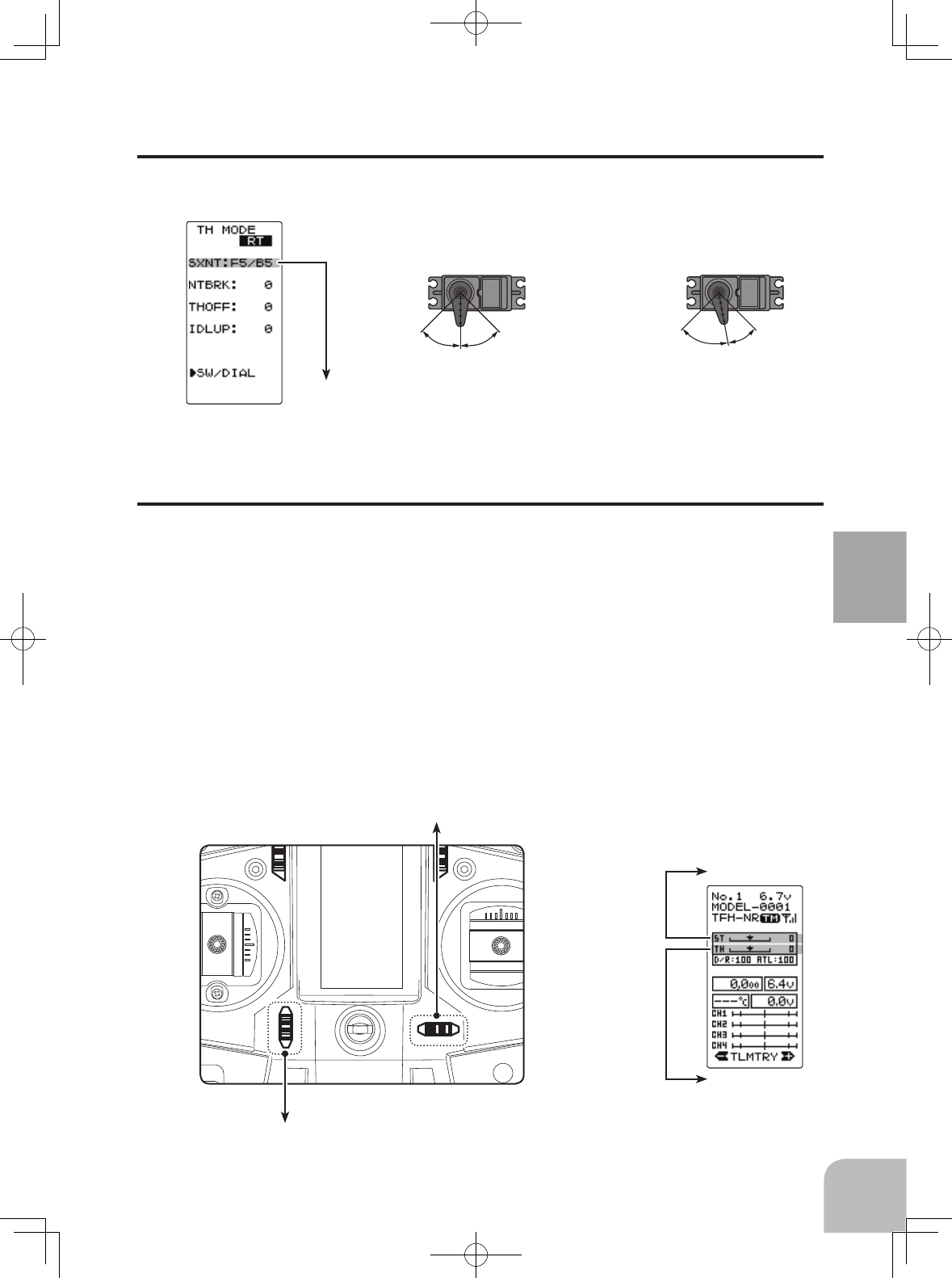
Throttle trim (DT2)
Steering trim (DT1)
Steering trim
Throttle trim
F5/B5 or F7/B3
5 : 57 : 3
F5/B5 F7/B3
Forward side Brake side Forward side Brake side
41
Initial Set-Up
Trims Initial Set-Up
- Steering trim (DT1) check
On the initial set-up, steering trim is assigned to the DT1 trim lever. Operate the lever
and make sure the marker moves on the ST graph. If default has been changed, test
steering trim in its new location. After checking the trim, set the trim display to the cen-
ter (N) position.
- Throttle trim (DT2) check
On the initial set-up, throttle trim is assigned to the DT2 trim lever. Operate the lever
and make sure the marker moves on the TH graph. If the default has been changed, test
the throttle trim in its new location. After checking the trim, set the trim display to the
center (N) position.
Throttle Mode Check
The throttle servo travel can be set to 5:5 or 7:3 for throttle stick operation as required
by the throttle mode function .
*This function is not available in "TH-STK : F10 mode".
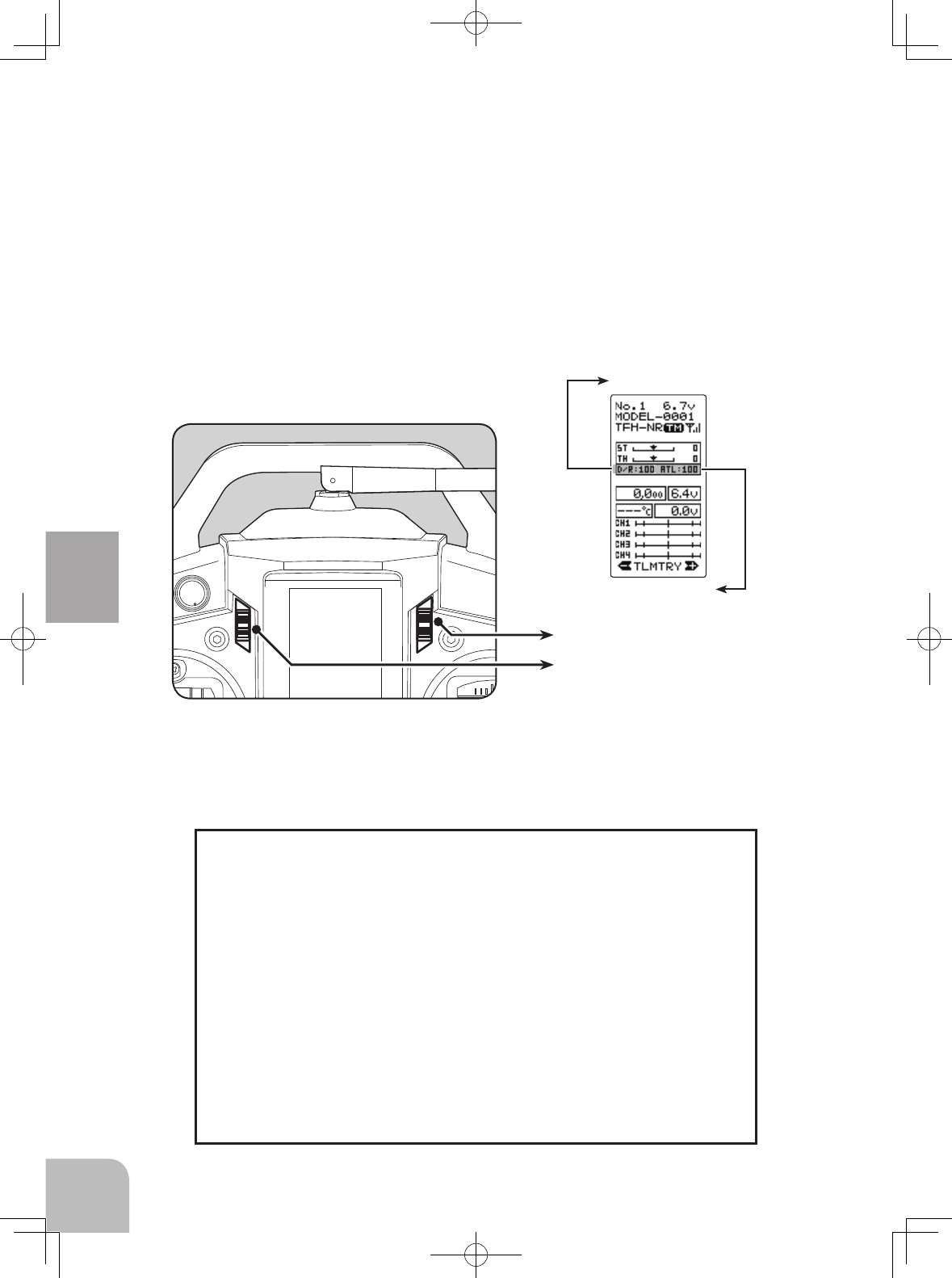
Throttle ATL
Steering dual rate
Steering dual rate DT3
Throttle ATL DT4
42
Initial Set-Up
(Set-Up Procedure When Installed In a Car)
When installing the servos in a car, performing function set-up in the following order is
recommended.
1Carry out the Trims Initial Set-up as described on the previous page.
2Set the servo direction of operation using the Reverse function.
- The servo installation method and linkage direction depend on the kit. Therefore, the servo
operation direction may have to be reversed relative to transmitter operation. Before install-
ing the servo, check the operating direction and set it using the Reverse function.
3Set the subtrim and adjust the servo neutral point.
4Set the throttle stick travel by adjusting the throttle stick mechanical ATL
to your liking.
- When the throttle stick travel is changed, set the servo travel as required using the adjuster
function.
5
Set EPA of each channel and adjust the servo throw (travel).
- Steering dual rate (DT3) check
At initial set-up, steering dual rate (D/R) is assigned to the DT3. Operate the lever and
check if the D/R value displayed on the screen changes. After checking D/R, set the
steering dual rate to 100%.
- Throttle ATL (DT4) check
At initial setting, throttle ATL (ATL) is assigned to the DT4. Operate the lever and
check if the ATL value displayed on the screen changes. After checking ATL, set throt-
tle ATL to 100%.
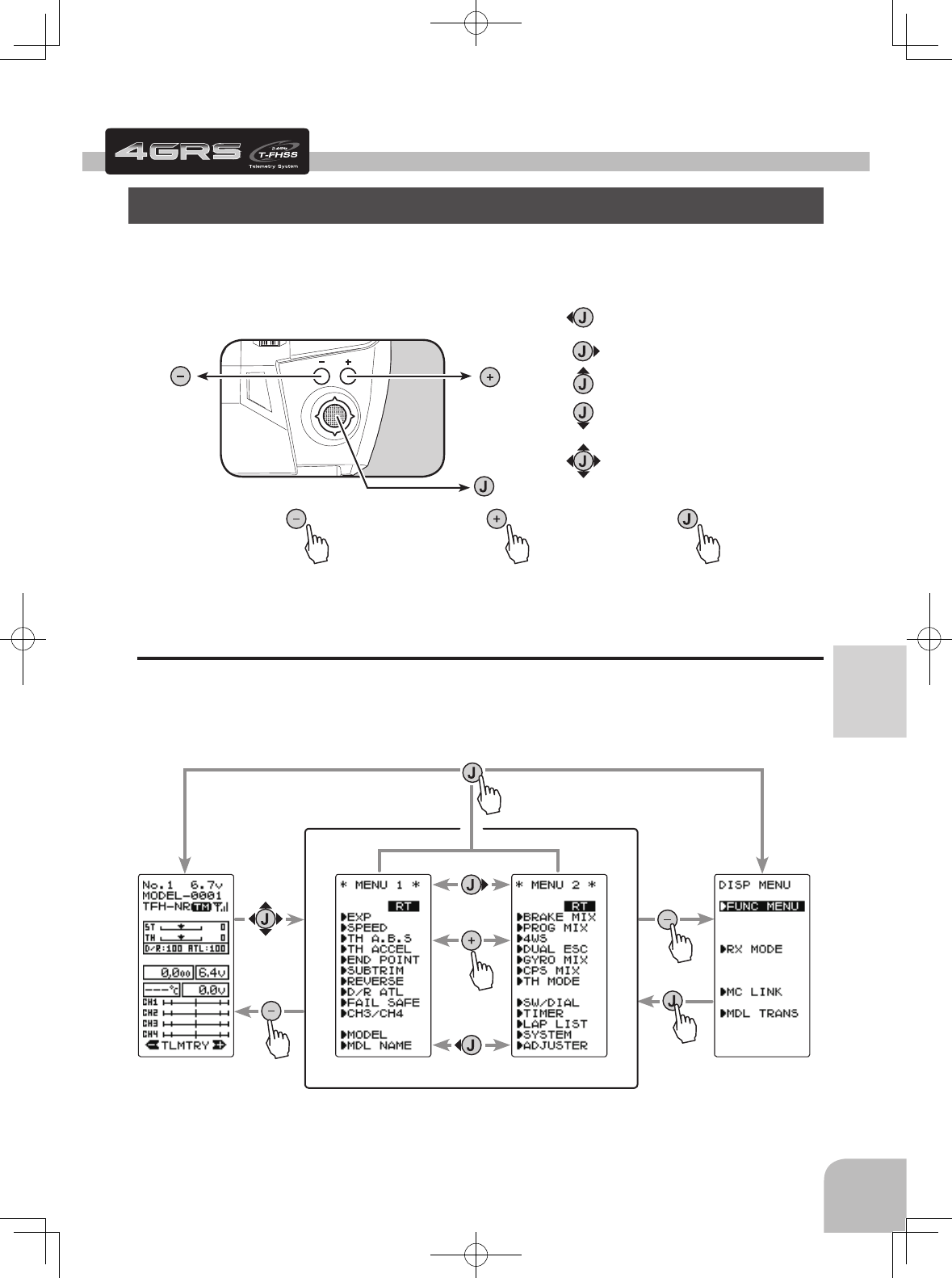
(+) button is pressed
Pres
s
(-) button is pressed
Pres
s
(JOG) button is pressed
(+) button (-) button
(JOG) button
Pres
s
(JOG) button up
(JOG) button down
(JOG) button left
(JOG) button right
(JOG) button up, down, left or right
Pres
s
Pres
s
Pres
s
Pres
s
Pres
s
(DISP MENU screen)(MENU 2 screen)(MENU 1 screen)(HOME screen)
On the MENU1 or 2 screen, move the
cursor to [RT] by (JOG)button up or
down operation and press the button.
On the DISP MENU screen, move the cur-
sor to "FUNC MENU" by (JOG) button up
or down operation and press the button.
43
Function Map
Function Map
Operation Of Screen
In this instruction manual, Edit Buttons are represented by the symbols shown below.
The (JOG) button can be operated in the 4 directions up, down, left, and right.
Selecting The Menu Screen
Refer to the map below for the method of displaying the function setting menu screen
from the PWR ON initial screen or DISP (display) screen and the method of returning
from the menu screen to the PWR ON initial screen or DISP (display) screen.